1lumen selects and reviews products personally. We may earn affiliate commissions through our links, which help support our testing.
Imalent BL50 review
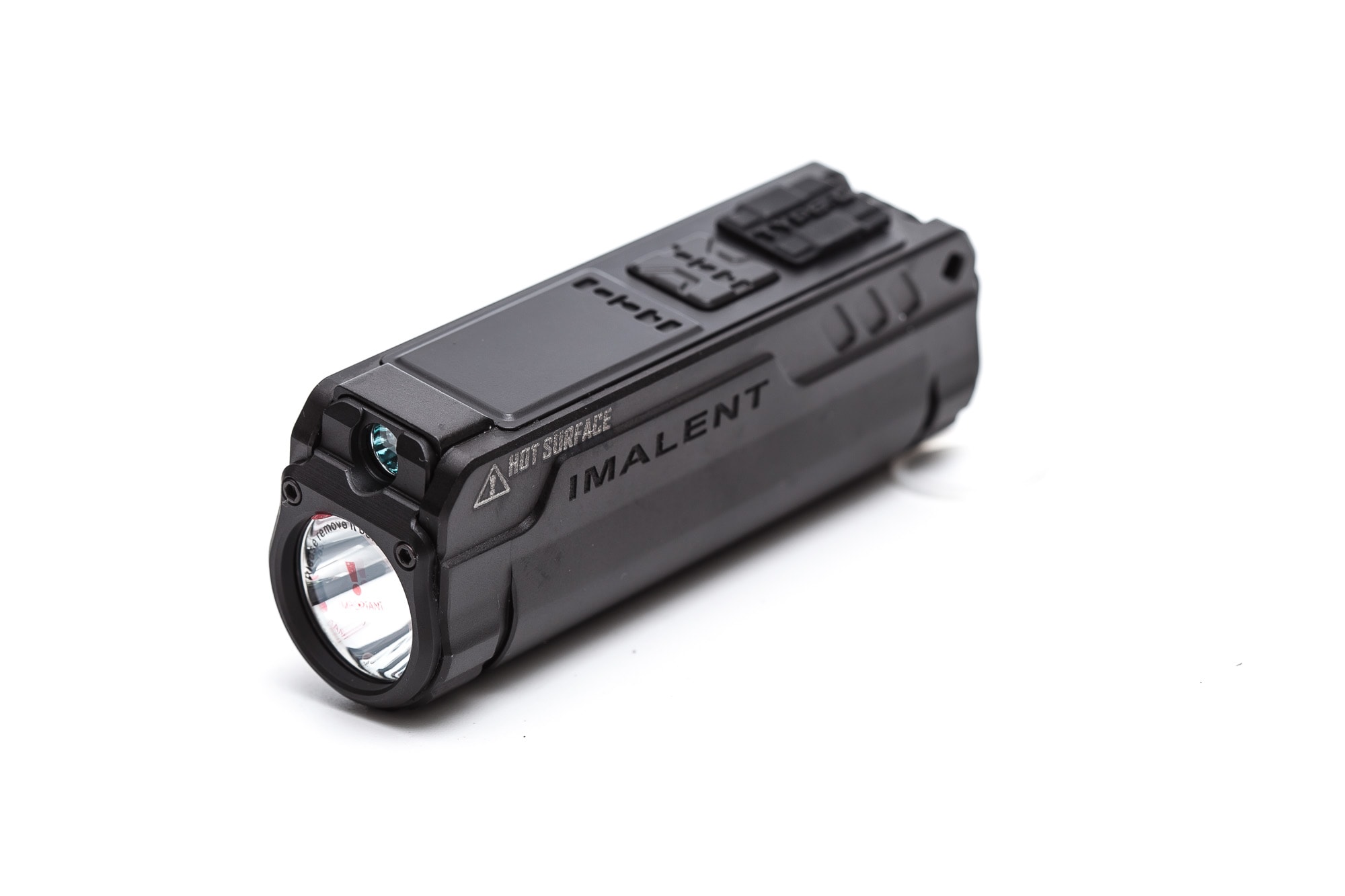
Imalent BL50 specifications
| Brand/model | Imalent BL50 |
|---|---|
| Flashlight category | EDC flashlight / UV flashlight |
| LED | 1*CREE XHP50.3 Hi + UV |
| Max. output | 3,600 Lumens |
| Max. beam distance | 428 meters |
| Max. beam intensity | 45,780 cd |
| Battery config. | battery pack (1*18650) |
| Onboard charging | USB-C |
| Modes | 6 |
| Blinkies | Strobe |
| Waterproof | IPX8 |
| Review date | February 2024 |
Review intro:
It has been 10 years since Imalent released their Imalent SA04 flashlight, which had a 4AA battery and featured an LCD touch-screen and the ability to mix beams. However, Imalent has since decided to take a different direction by removing the touch screen and tint mixing capabilities from their newer models.
For anyone new to the flashlight world, Imalent was one of the first companies to include 2 types of emitters (warm white and cold white) and a touch screen to mix them.
Currently, we are examining the Imalent BL50. It comes with a display but lacks touch capability and LED mixing features. Instead, the BL50 has two kinds of emitters: one for white light and the other for UV.
So let’s see how it works and performs.
Oh, you need to unlock the flashlight first. Triple-click the switch for unlocking.
What’s in the package
The packaging is adequate, with the following inside:
- Imalent BL50
- USB-C to USB-C charging cable
- Lanyard
- O-rings
- Manual
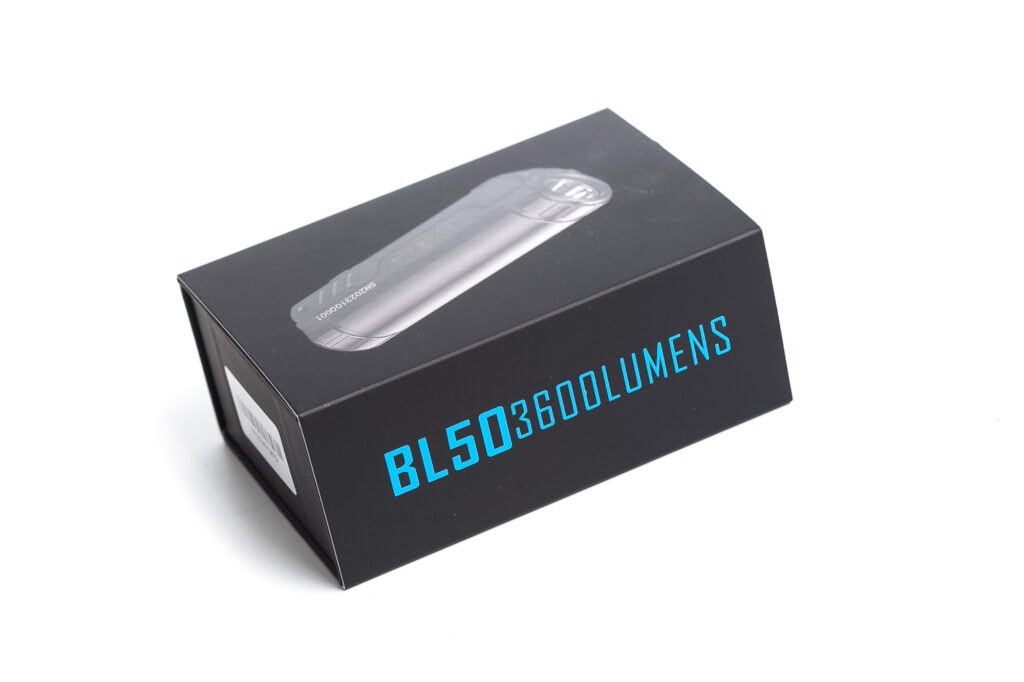
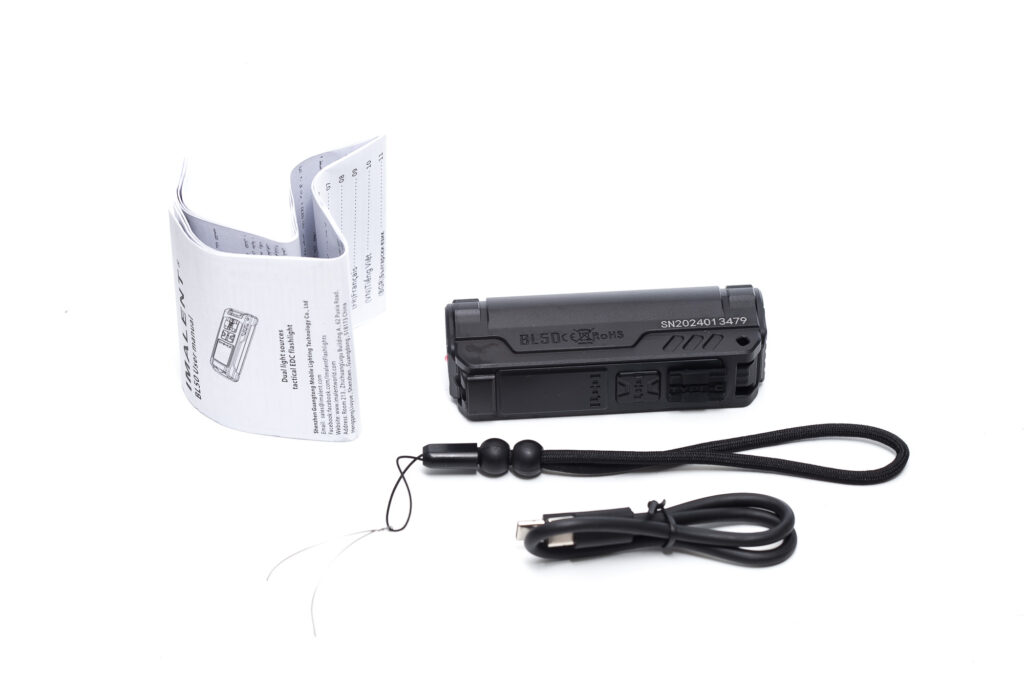
Flashlight in use, Build Quality, and Warranty
The BL50 has a shape similar to that of a gun-mounted light. One of its sides is flat, while the other is rounded. It comes with two electronic switches that have unique features. The rear switch is used for the main modes, and the side switch is used for accessing two special modes, including the UV light.
For carrying, you have a couple of options. Since it lacks traditional knurling, it can feel slippery when used normally, so pocket carry is recommended. The package also included a lanyard so that you can hang the flashlight off your wrist.
If you will pocket carry it, use the lockout feature because the e-switches are very sensitive. The light won’t roll off the table, which could be seen as another useful feature.
While using the light, I noticed that you can always access the special modes (5lm output and UV light), even if you use the rear switch to turn the light on. But it does not work the other way around. If you use any of the two special modes, you can not use the rear switch to get a normal mode.
If you ask me about the use cases for this light, it is definitely for EDC use, but it can also come in handy while camping. You can use the UV light to find strange stuff hidden from our eyesight. BTW. I would not recommend using that UV light in your kitchen. If you are sensitive to dirt (Mysophobia, germophobia) I would not recommend using UV light. You can also use the UV light for other useful stuff like finding scorpions, painting anomalies, etc.
Warranty:
1. Free Repair/Replacement within 15 Days after Receipt
Within 15 days after receipt and under normal use, any quality problem with your IMALENT flashlight, you can either send the light to repair or a new one of the same type with same specifications will be replaced; if the same model has been discontinued or not able to be replaced timely due to other reasons, another model with same or better performance will replaced instead;
2. 24 Months’Free Repair
Within 24 months after receipt and under normal use, any quality problem with your IMALENT flashlight, you can send it to repair for free;
Torch with built-in battery and battery stick, 12 months warranty.
3. Lifetime Limited Maintenance
IMALENT provides you with lifetime limited maintenance for your flashlight, after the 24 months’ free repair period ,any problems with your flashlight, IMALENT can repair and maintain it ,repairing fee will be charged on an actual cost basis, no labor cost charged;
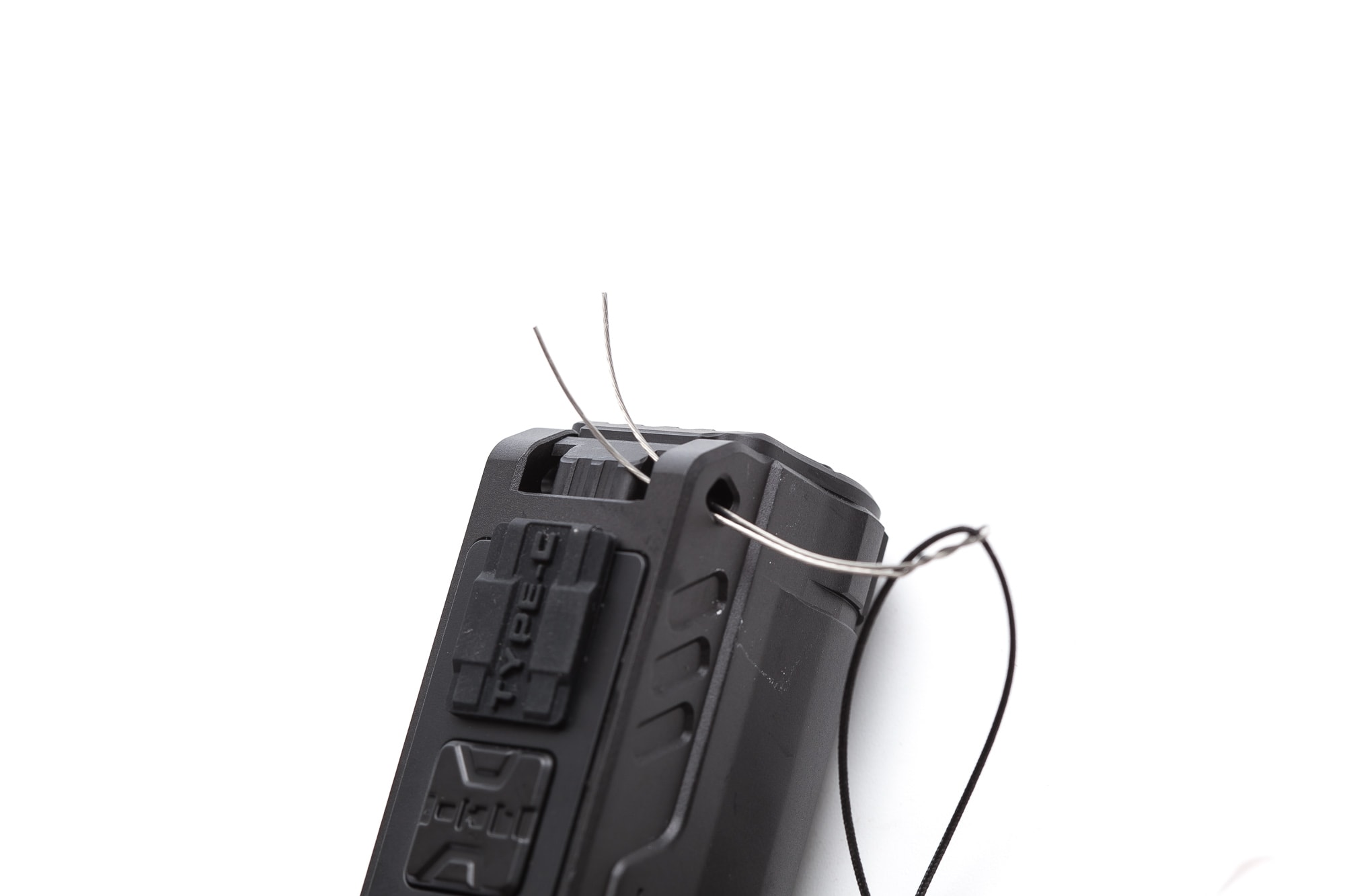
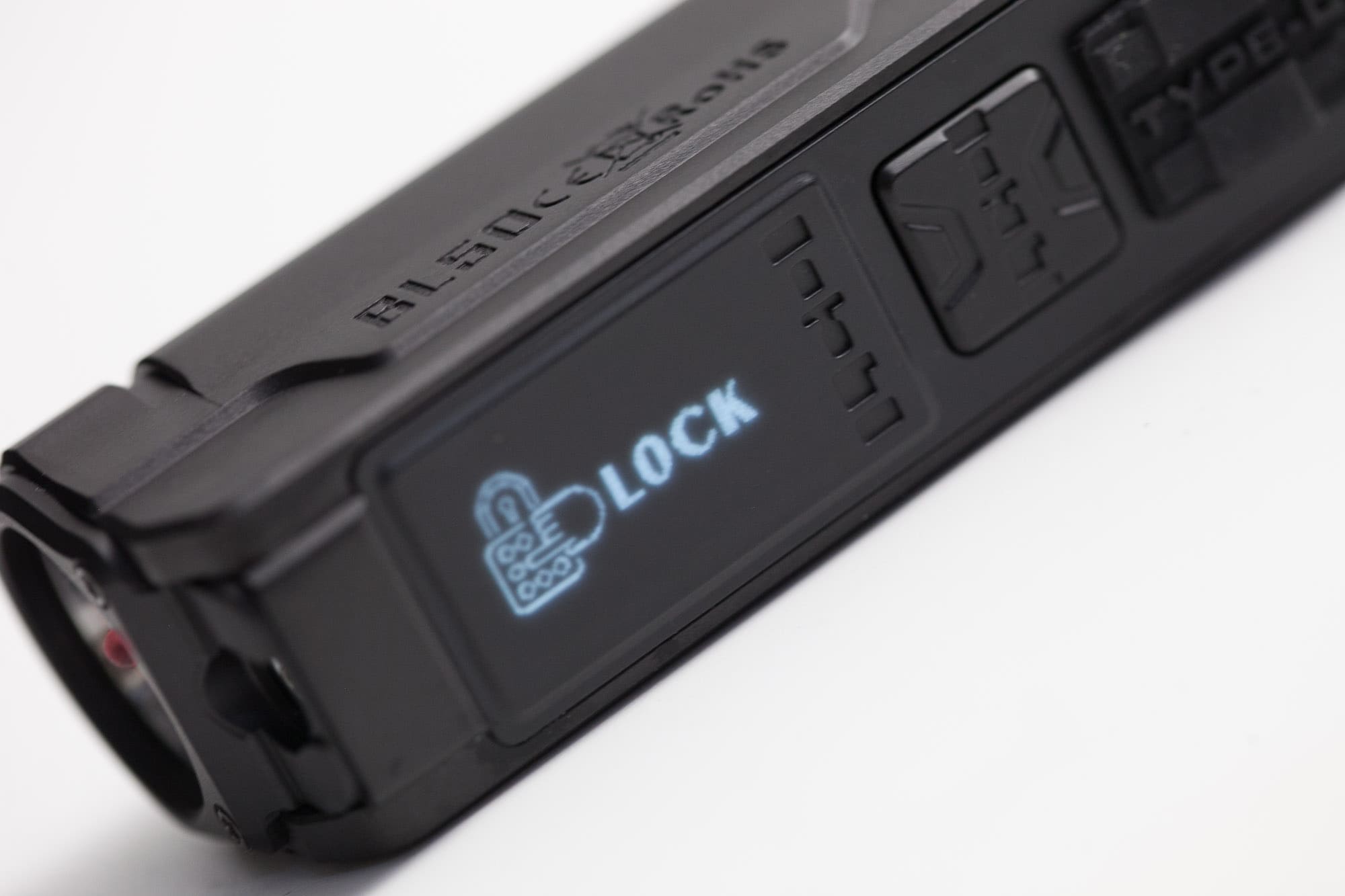
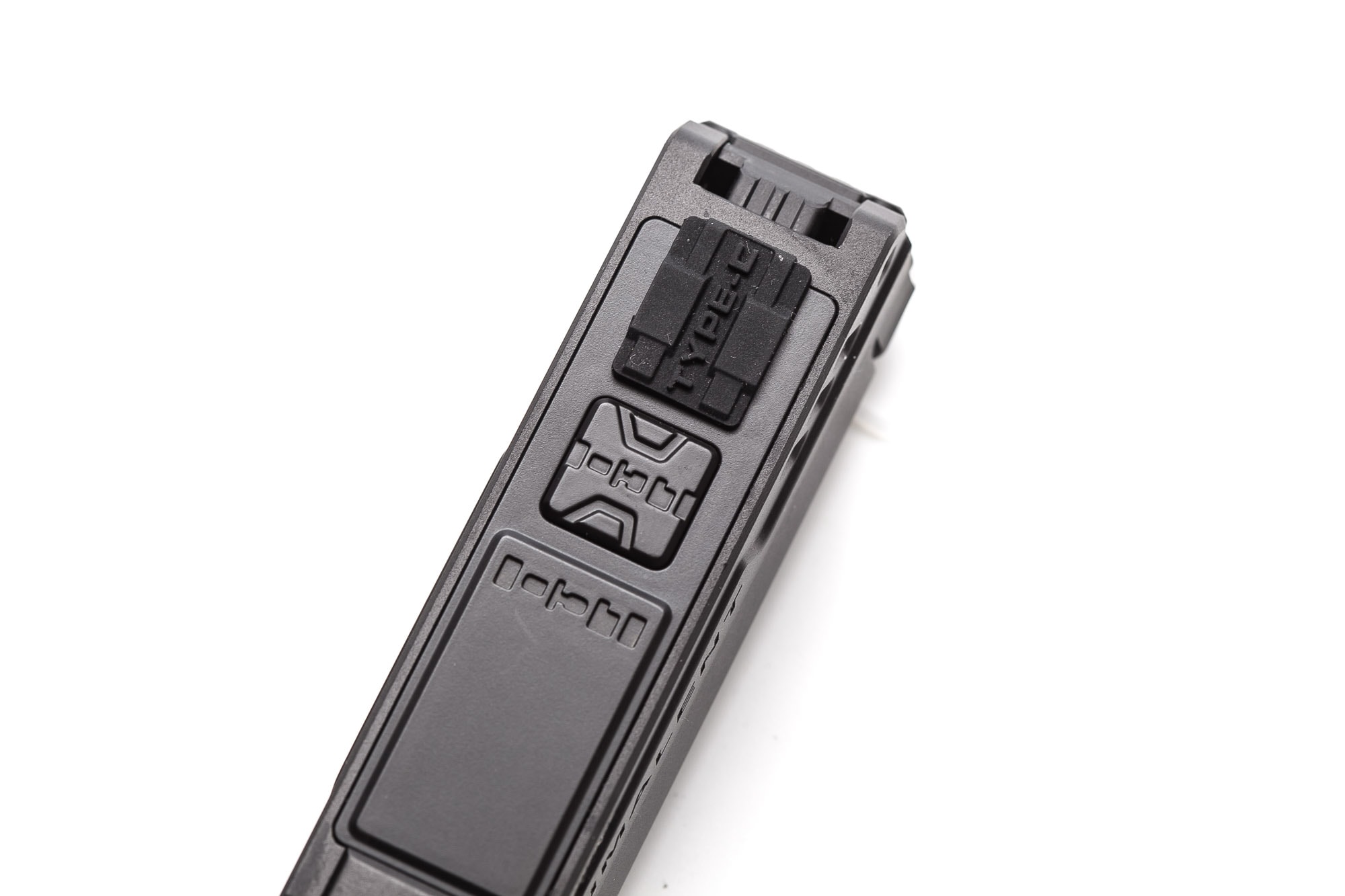
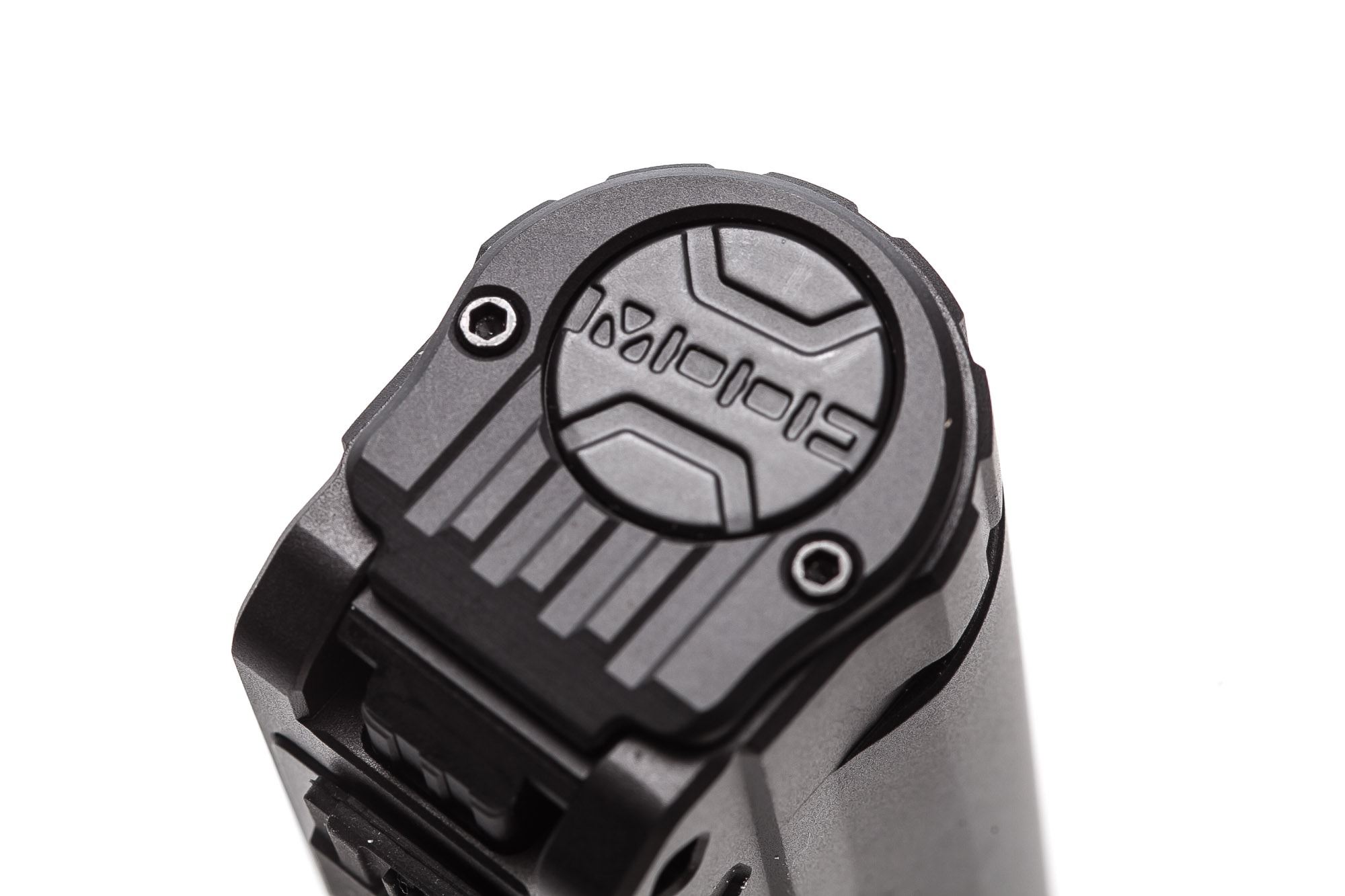
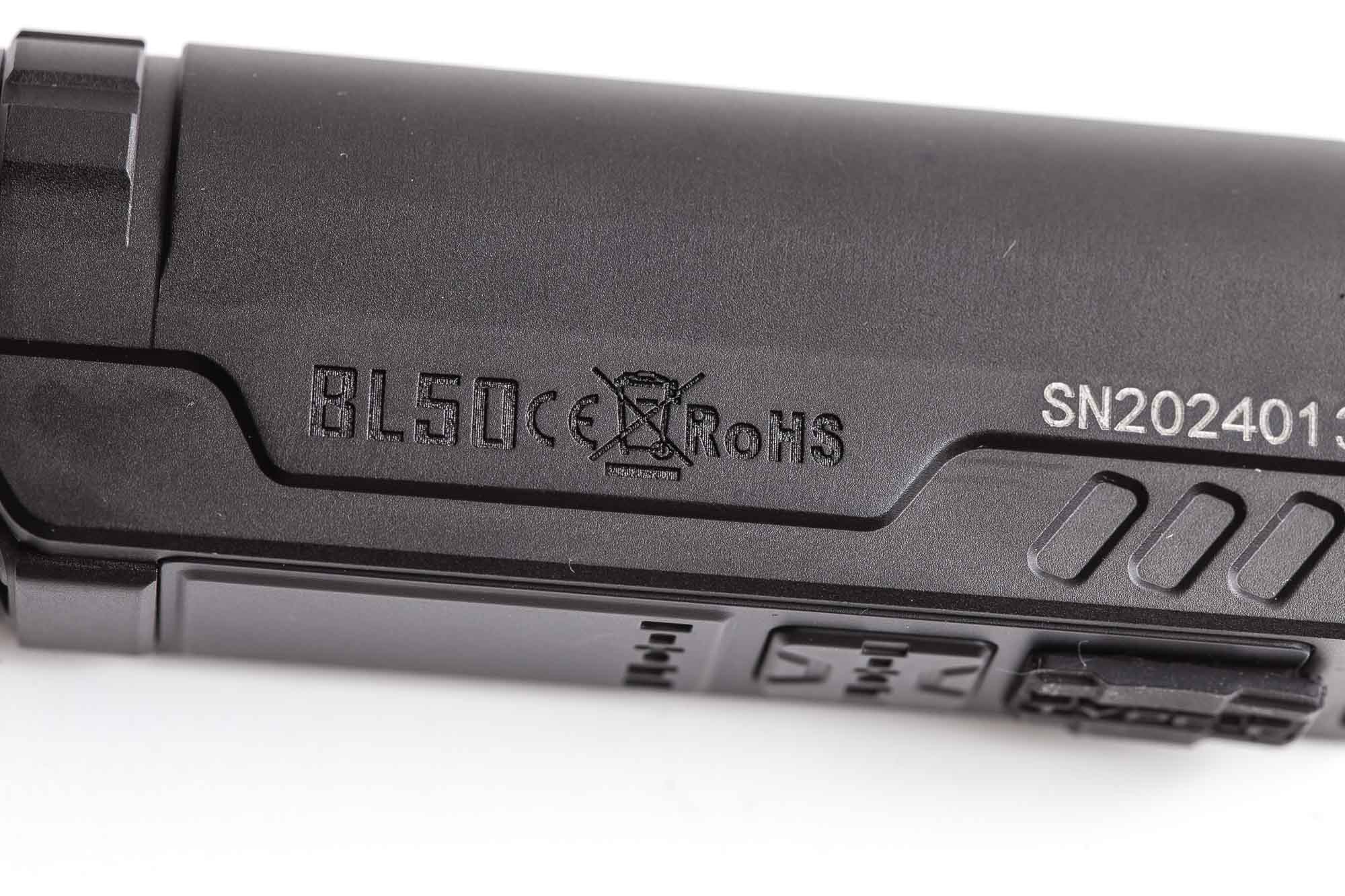
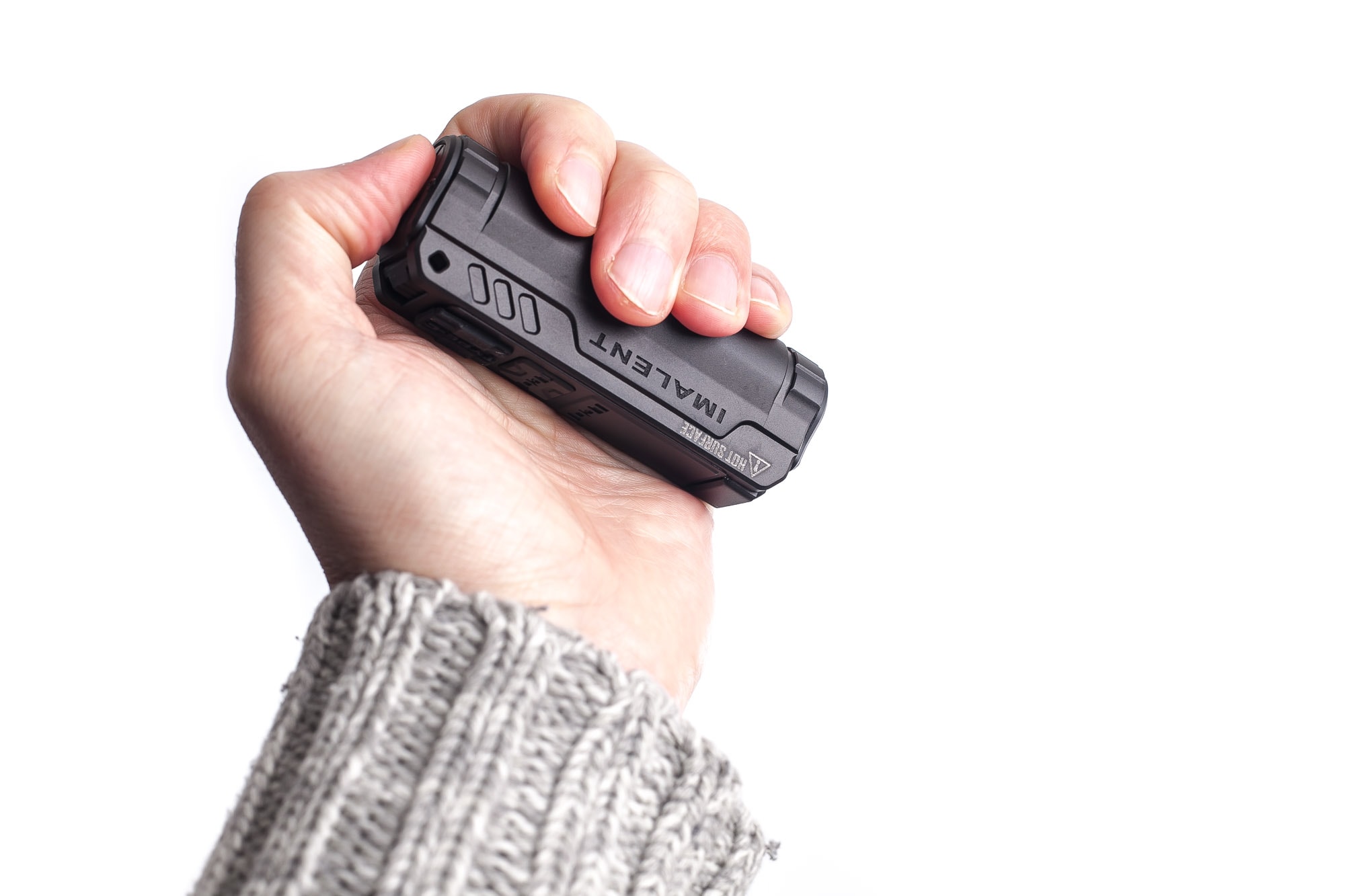
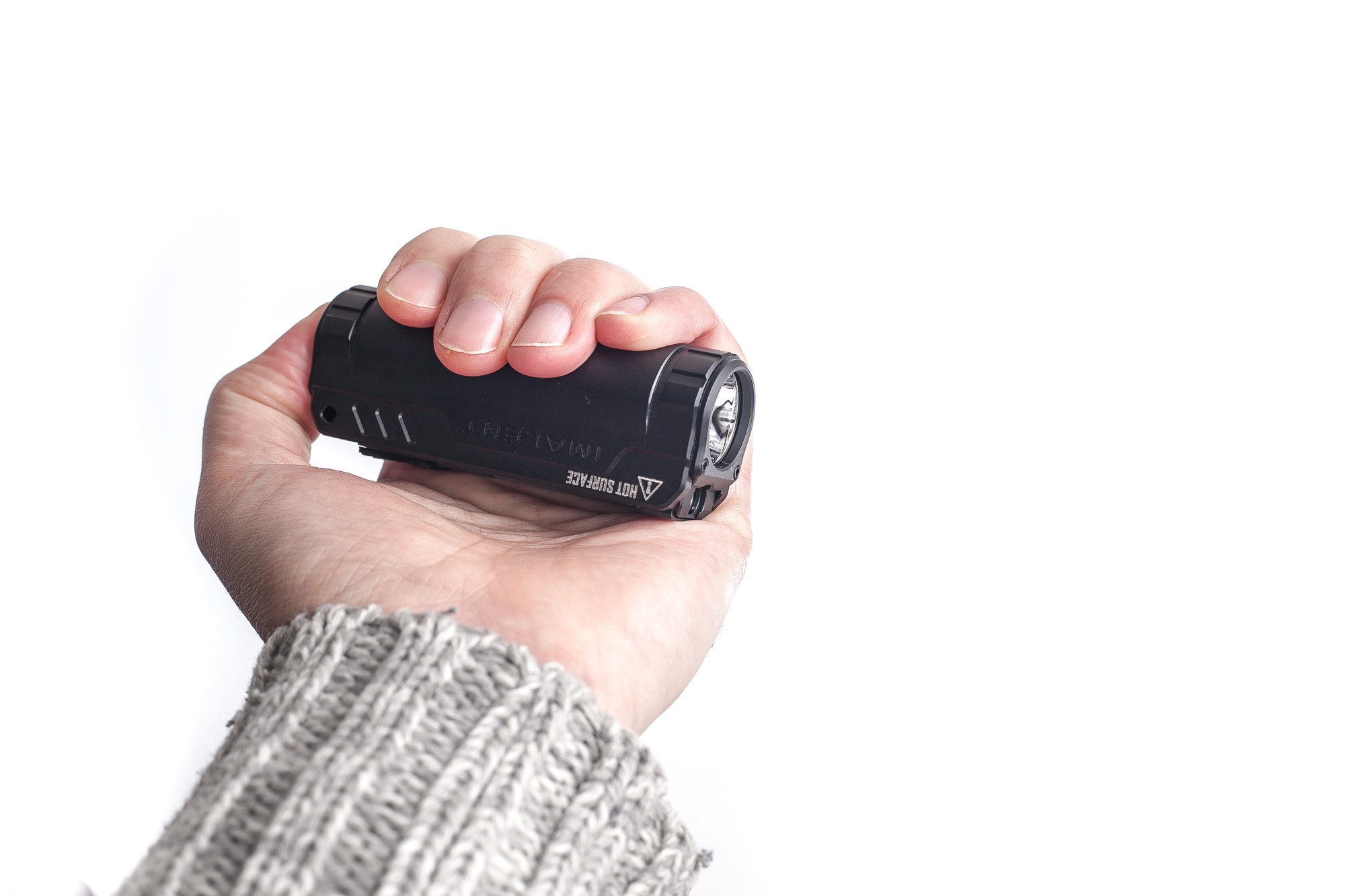
LED, Lens, Bezel, Beam, and Reflector
Imalent BL50 uses two emitters; a normal white LED, CREE XHP50.3 Hi, and a UV LED. The CREE XHP50.3 Hi is a domeless LED and produces a cold white but throwy beam. It is centered very well in a smooth, not-too-shallow reflector. A purple AR-coated lens protects the reflector, and a black bezel finishes it. The bezel can be removed by removing two small hex screws.
On the other hand, the UV LED sits in a very shallow reflector, and makes a pretty wide ‘beam’. To activate the UV light, double-click the side switch at any time, including all normal white light modes.
The beam has a clear hotspot, and if you look carefully, you’ll notice some tint shifts, which are pretty common with XHP emitters. Right in the center of the beam, the tint is slightly greenish, while the rest of the hotspot is more ‘purplish.’ There is a pretty quick transition from hotspot to spill, with a few slight visible rings.
Spectral measurements:
I used a Sekonic C800 spectrometer to measure the flashlight at a distance of 5 meters.
| Mode: | CCT: | CRI Ra: | duv | Tm30-Rf | Tm30-Rg |
|---|---|---|---|---|---|
| Turbo | 6783K | 70.4 | 0.0012 | 70 | 95 |
| Mid 1 | 6019K | 69.3 | 0.0079 | 72 | 92 |
This means that the beam gets colder the higher the output mode. The CRI is average, and the tint is greenish in the center of the beam.
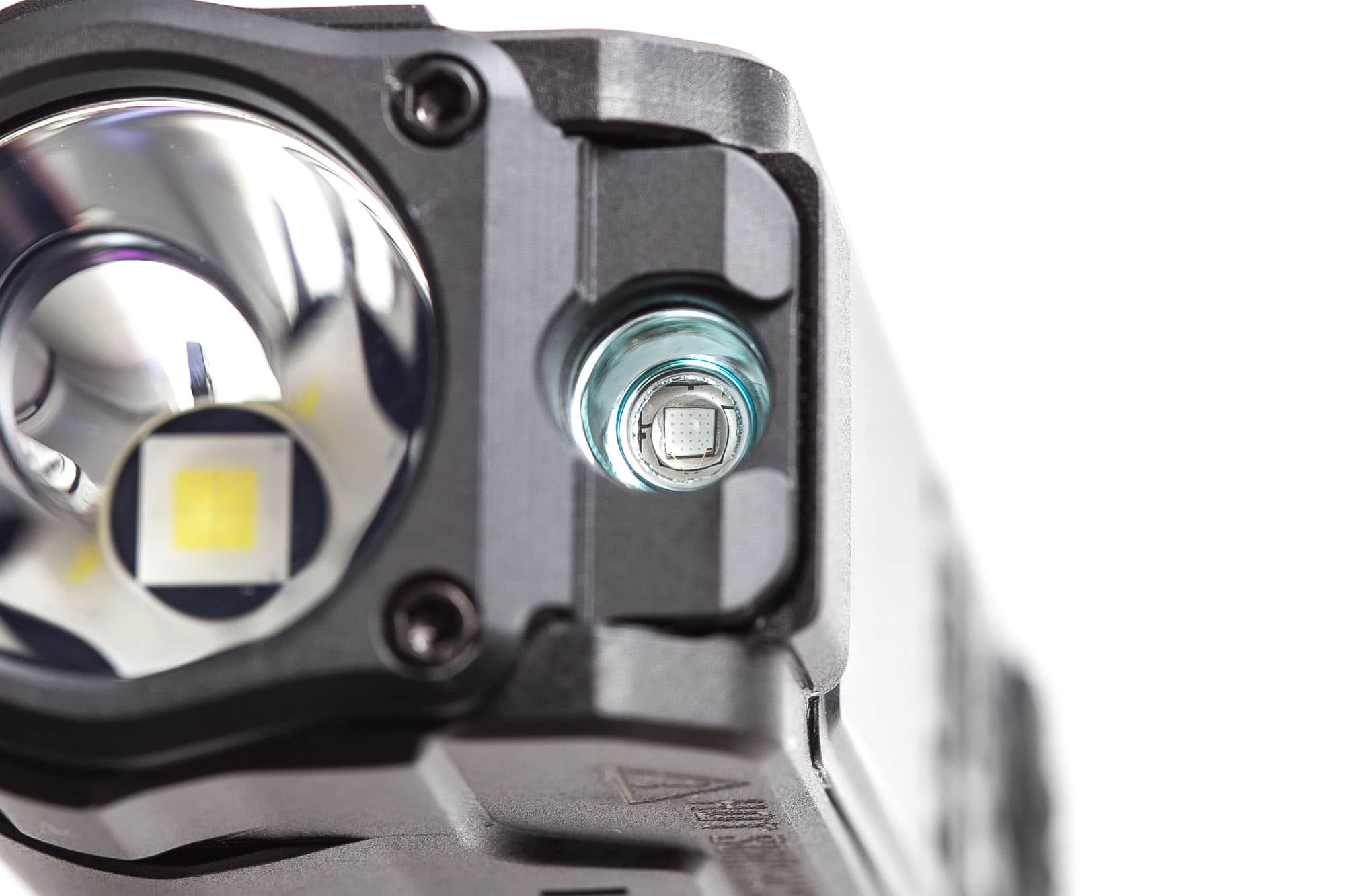
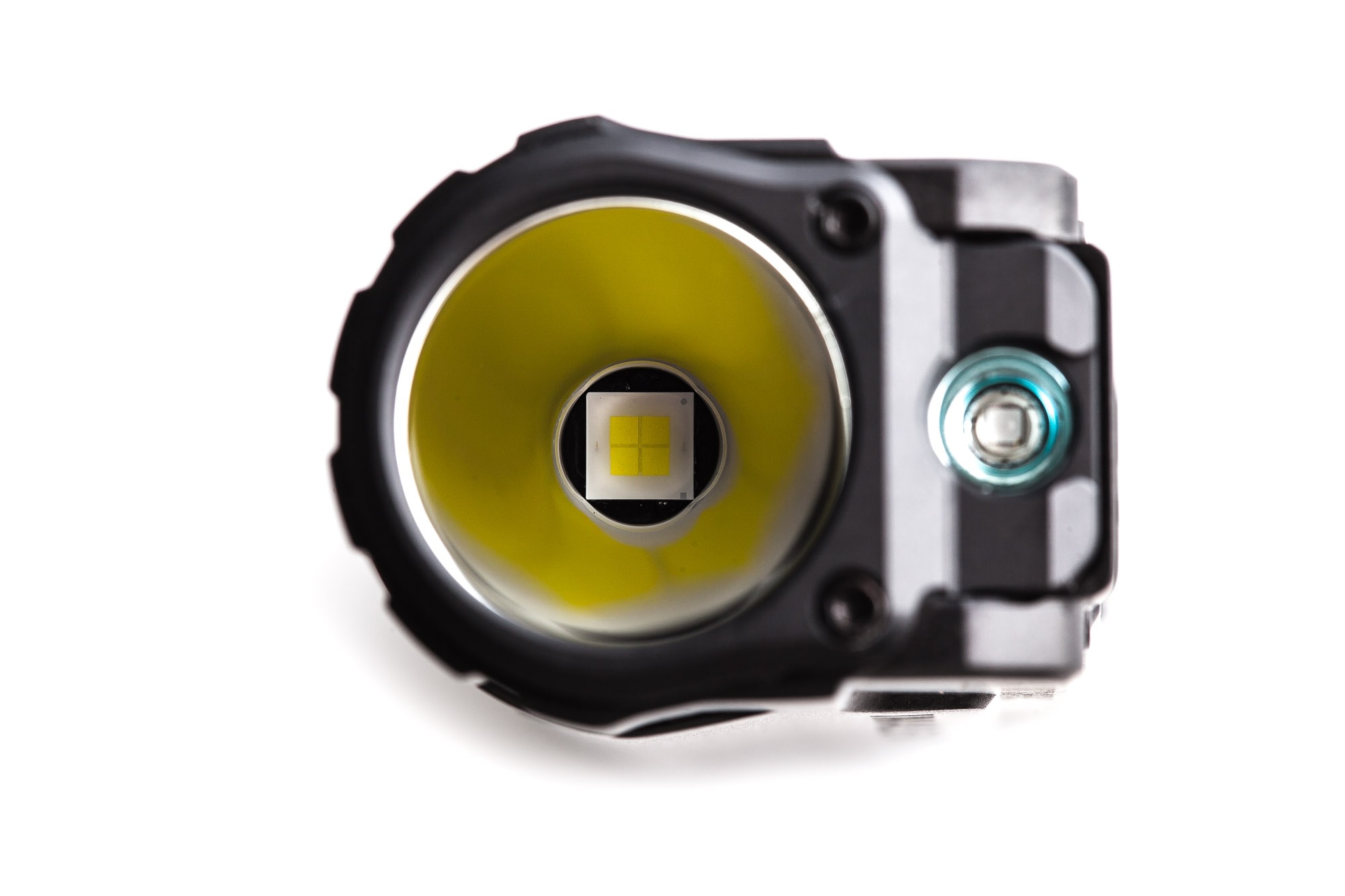
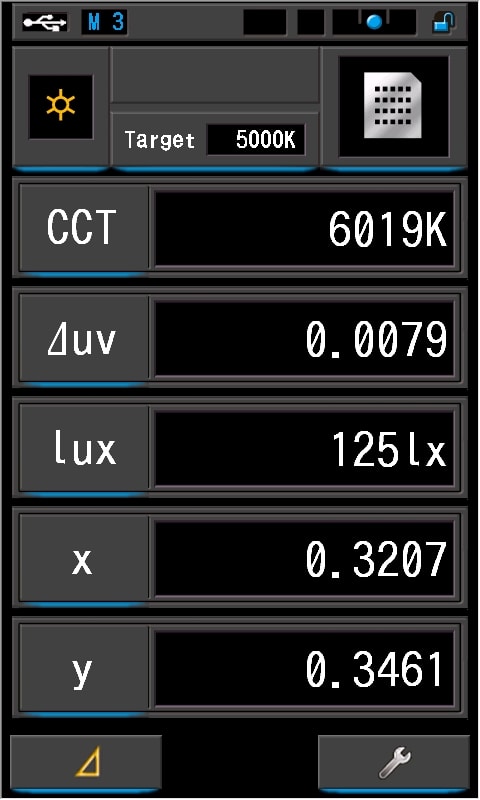
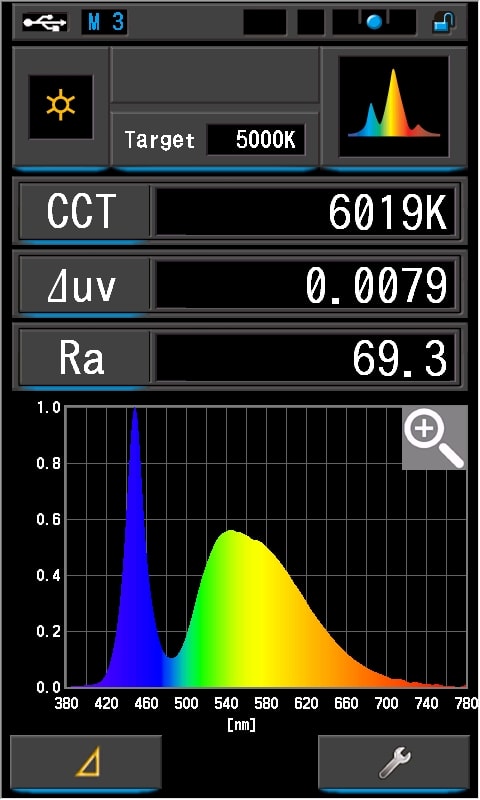
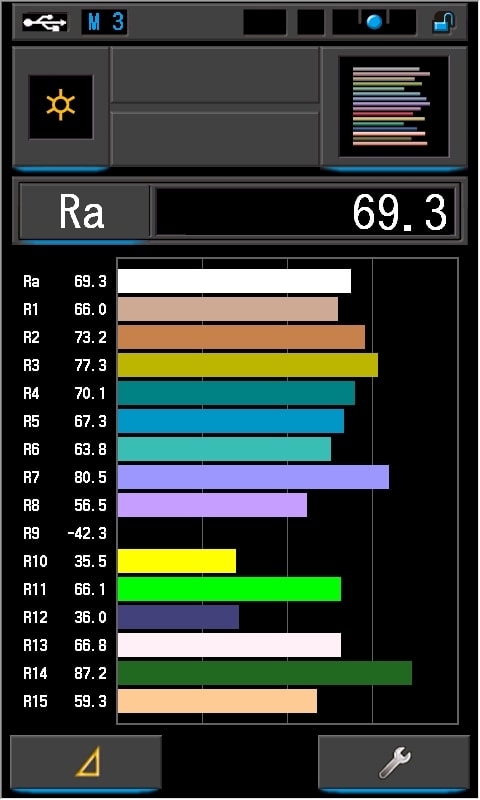
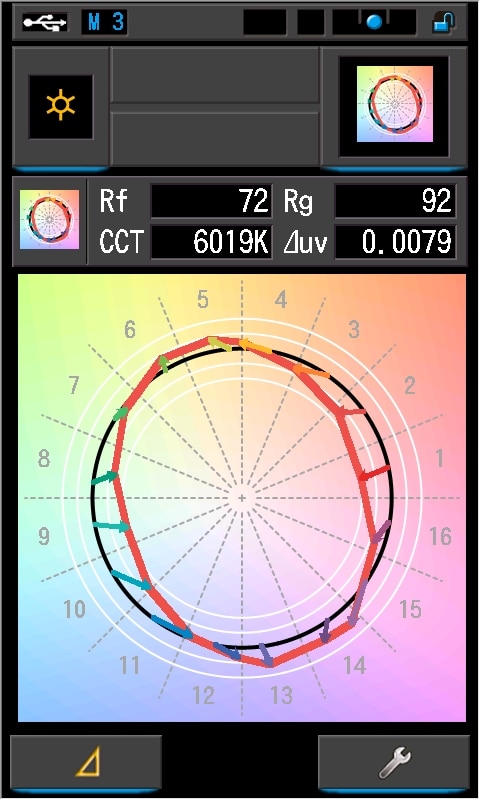
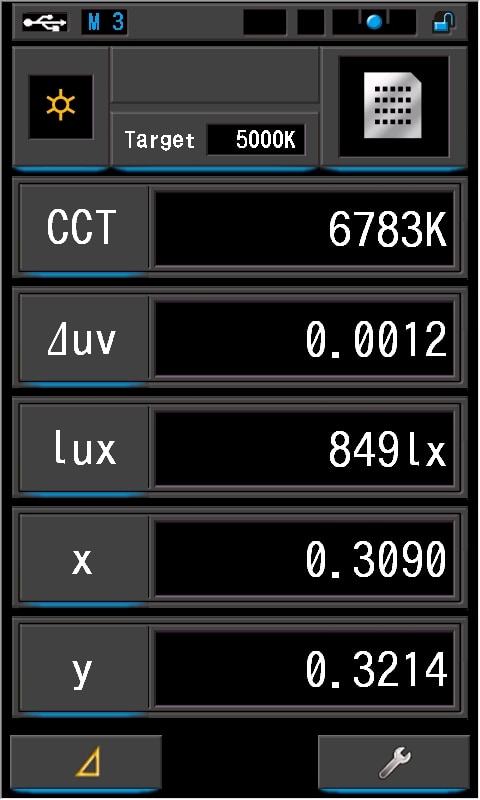
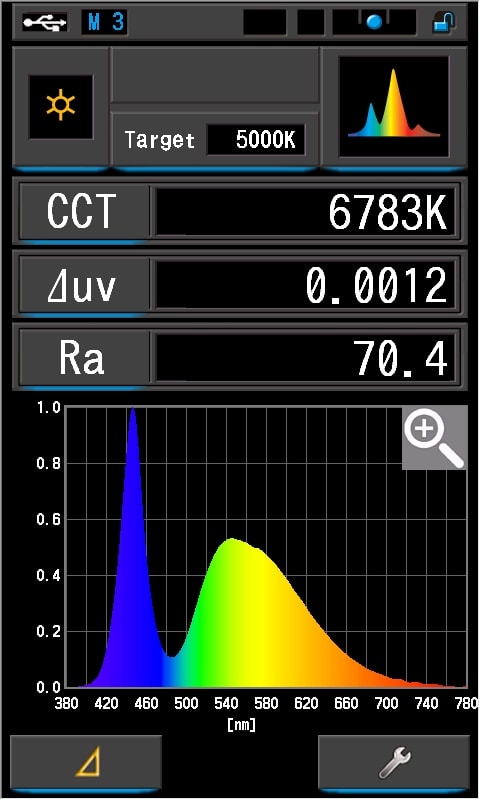
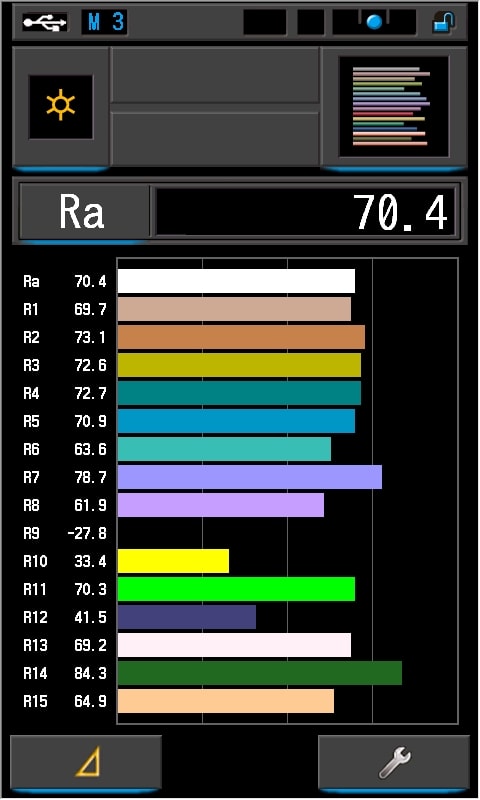
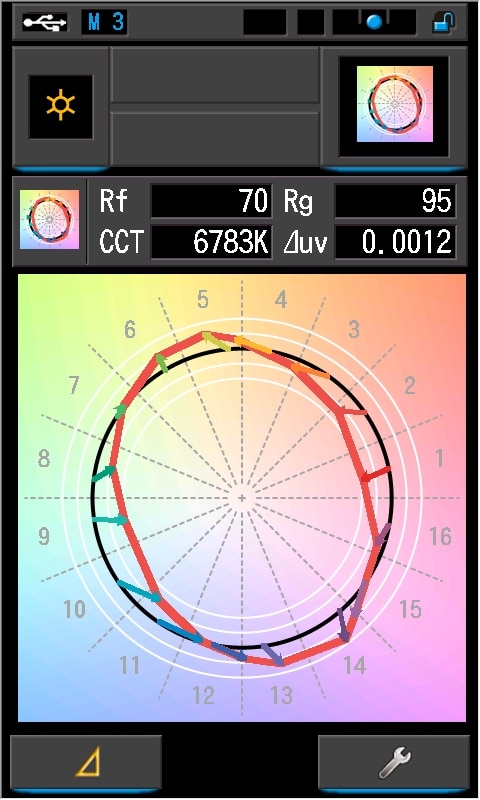
Dimensions and its competition
Dimensions:
| Imalent BL50 | Millimeters | Inches |
|---|---|---|
| Length | 94 mm | 3.7 in |
| Widest diameter | 35 mm | 1.4 in |
| Body diameter | 28 mm | 1.1 in |
Dimensions are rounded to the nearest millimeter and the nearest tenth of an Inch.
Weight:
| Imalent BL50 | Weight in grams | Weight in oz. |
|---|---|---|
| Imalent BL50 | 154 g | 5.5 oz |
Weight is rounded to the nearest gram and tenth of an Oz.
Imalent BL50 Flashlight comparison
Size compared to other EDC flashlights
Group 1, from left to right: Nitecore EDC27, Olight Arkfeld, Imalent BL50, Wuben X2, Nitecore TUP
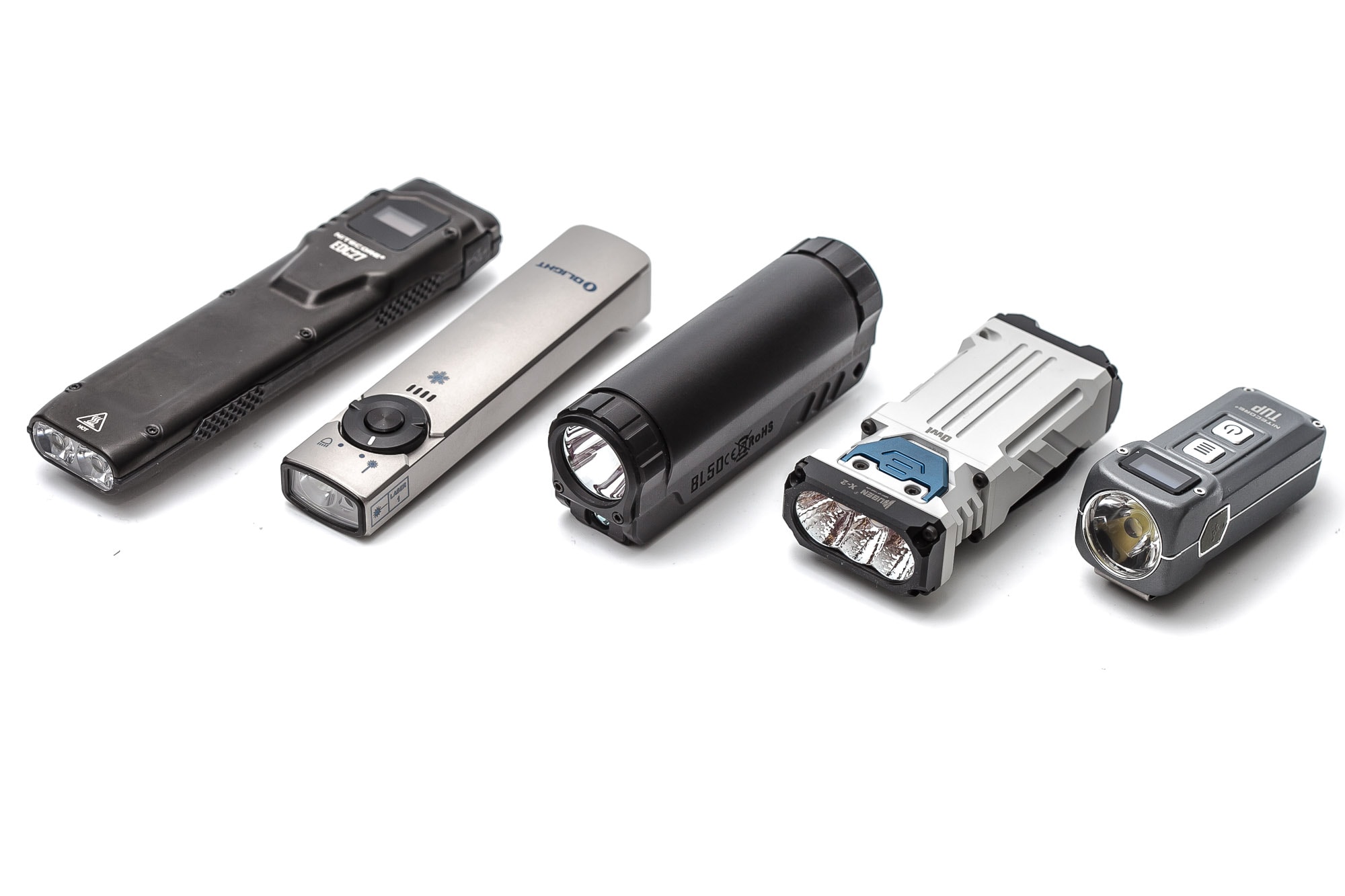
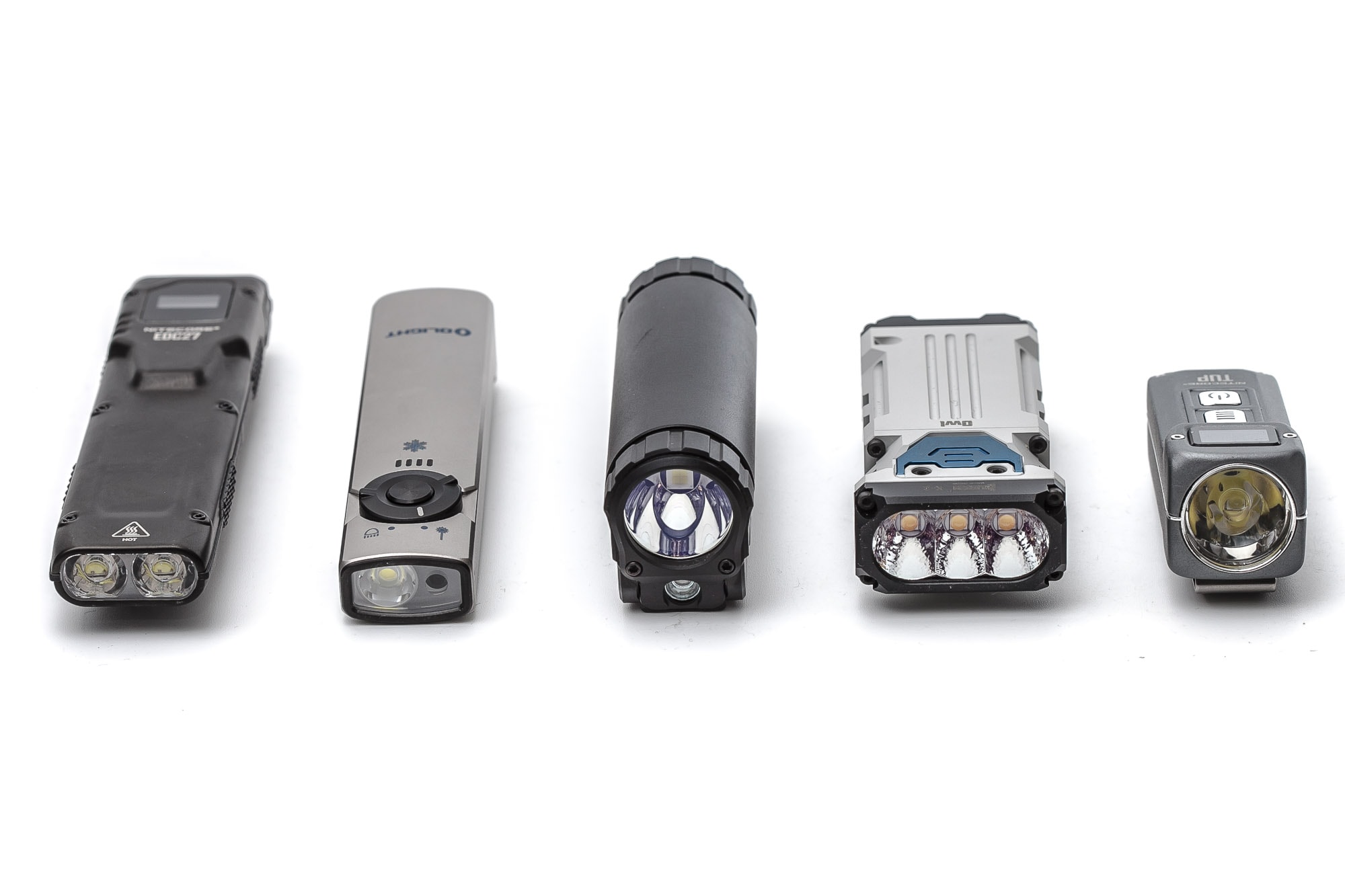
Imalent BL50 UI : User interface and driver
There are two user interfaces, each with a dedicated switch. The rear switch is for the main modes, and the side switch is for the 2 (actually 3) special modes.
Before diving into the User Interface, I want to complain a bit about the mode naming in their manuals and website. Oftentimes, Imalent uses different names for different countries or sometimes different names between the manual and the website. The English manual starts with a Moon mode, but in the German manual, it starts with Low. And on top of that, I think Imalent uses too many modes, which sometimes makes their naming so strange. They go from Moon to Mid Low.. why not Low? I think a Moon mode, Low, Mid, High, and Turbo would have been enough.
Something else confusing is the lack of added Strobe mode to the specifications overview. It’s usually hidden somewhere in the manual.
Interestingly, the Special modes can always be accessed from Off and On. Meanwhile, the normal modes can only be accessed from Off.
This means you can turn on the UV mode while using High mode at 2,000 lumens. The benefits? None that I know of. But perhaps I am missing something.
The available main modes:
- Moon, Mid Low, Mid 1, Mid 2, High, Turbo (strobe is hidden)
The available special modes:
- 5 Lm white light
- UV light
How the UI works when the flashlight is still turned OFF:
- Side switch: single click: 5lm white light
- Side switch: double click: UV light
- Side switch: 3-clicks: lockout mode
- Side switch: long press: nothing
- Rear switch: single click: to last used mode, mode memory
- Rear switch: double click: Turbo mode (another double click for Strobe)
- Rear switch: triple click: Lockout mode
- Rear switch: long press: nothing
How the UI works when the flashlight is turned ON in NORMAL mode:
- Side switch: single click: 5lm white light (if you double click the side switch you get White + UV)
- Side switch: double click: UV light activates besides the Normal mode
- Side switch: 3-clicks: nothing
- Side switch: long press: nothing
- Rear switch: single click: flashlight turns OFF
- Rear switch: double click: Turbo mode
- Rear switch: triple click: strobe
- Rear switch: long press: nothing
Shortcuts within the UI:
- To Turbo: double click rear switch from Off and On
- To Moon: single click side switch
- To Strobe: not directly, but you can access it from Turbo mode by a double click
- UV light: double click side switch
Mode memory:
- Yes
Blinky modes:
- Strobe. Can only be reached from Turbo mode.. (double click for Turbo, and another double click for Strobe)
Low battery warning:
- OLED display shows low battery
Lock-out mode:
- Yes. A triple click will activate Lockout mode
PWM:
- Not noticed by eye.
Firmware / UI Conclusion:
- I like the fact that there is a Moon mode accessible from the side switch and the UV mode as well. I don’t see the benefit of activating UV using Mid2, High, or Turbo mode, though.
- Single-clicking the side switch will activate Moon mode at all times. This can be pretty handy, but I’m not sure what the real benefit is if you could just use a Long press to activate it.
Imalent BL50 Charging and batteries
If you prefer flashlights with replaceable batteries, you are out of luck. The BL50 uses a built-in battery pack with a single 18650 battery and a capacity of 3,000mAh.
Upon arrival, the OLED display showed a voltage of 4.03V, which is pretty high for shipping and long-term storage. But on the positive side, you can use the flashlight straight out of the box.
Since you can’t remove the battery, the flashlight needs built-in charging, and that’s with USB-C. They even included a USB-C to USB-C charging cable. The port is covered by a rubber flap, that stays in place, but that’s all. After quite a bit of use, it doesn’t fully close off the port.
Charging is pretty quick, at 9V and 2.9 Amps, with a total of 27 watts.
This means that the specified 1.5-2.5 hours is easily met. I tested the charge time three times in a row, and they were 49, 45, and 45 minutes respectively. That’s twice as fast as specified.
| Charge type | Fits | No fit | Charge time |
|---|---|---|---|
| Flashlight with onboard USB-C | – | – | 45-49 minutes at 9V |
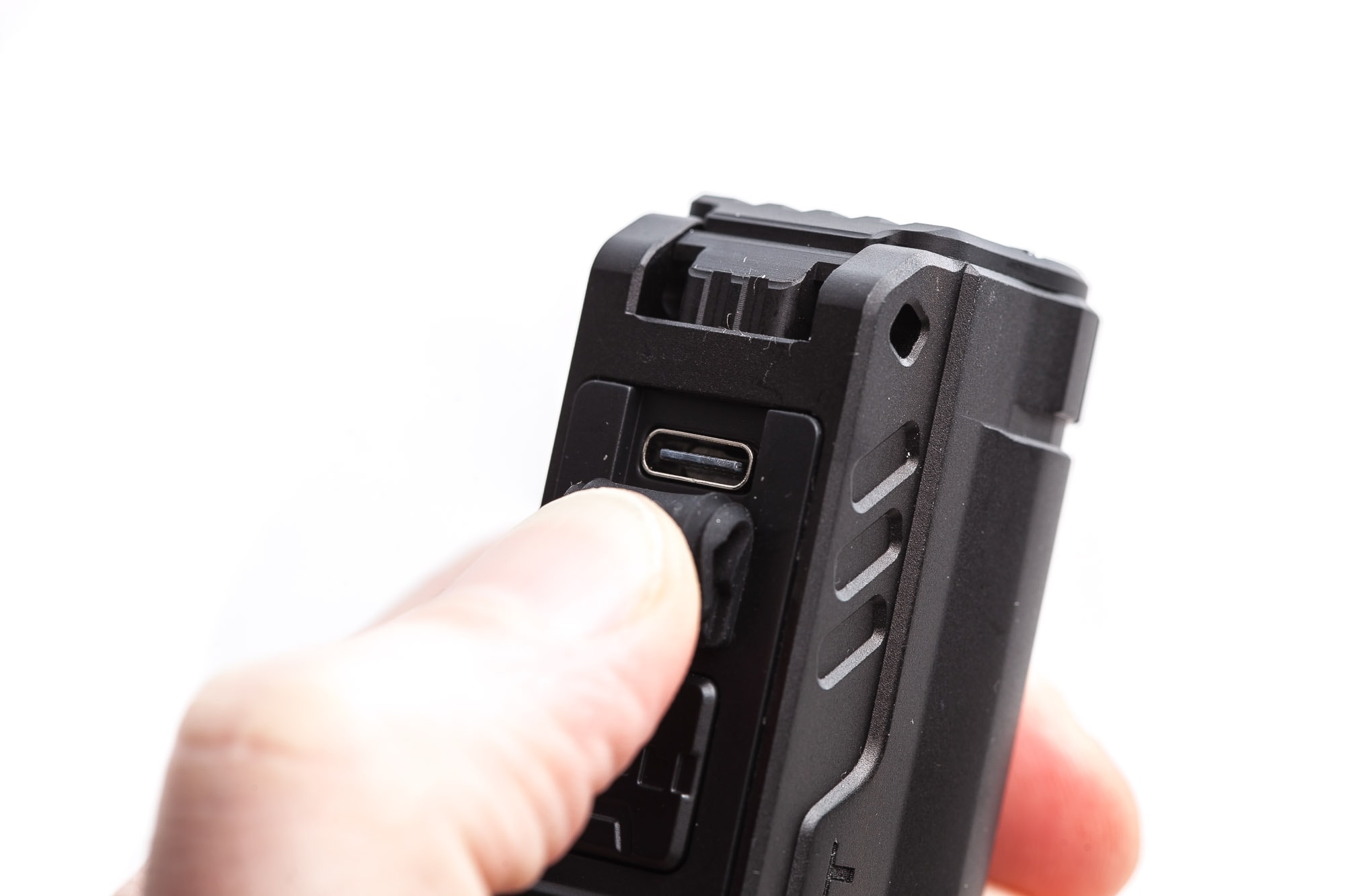
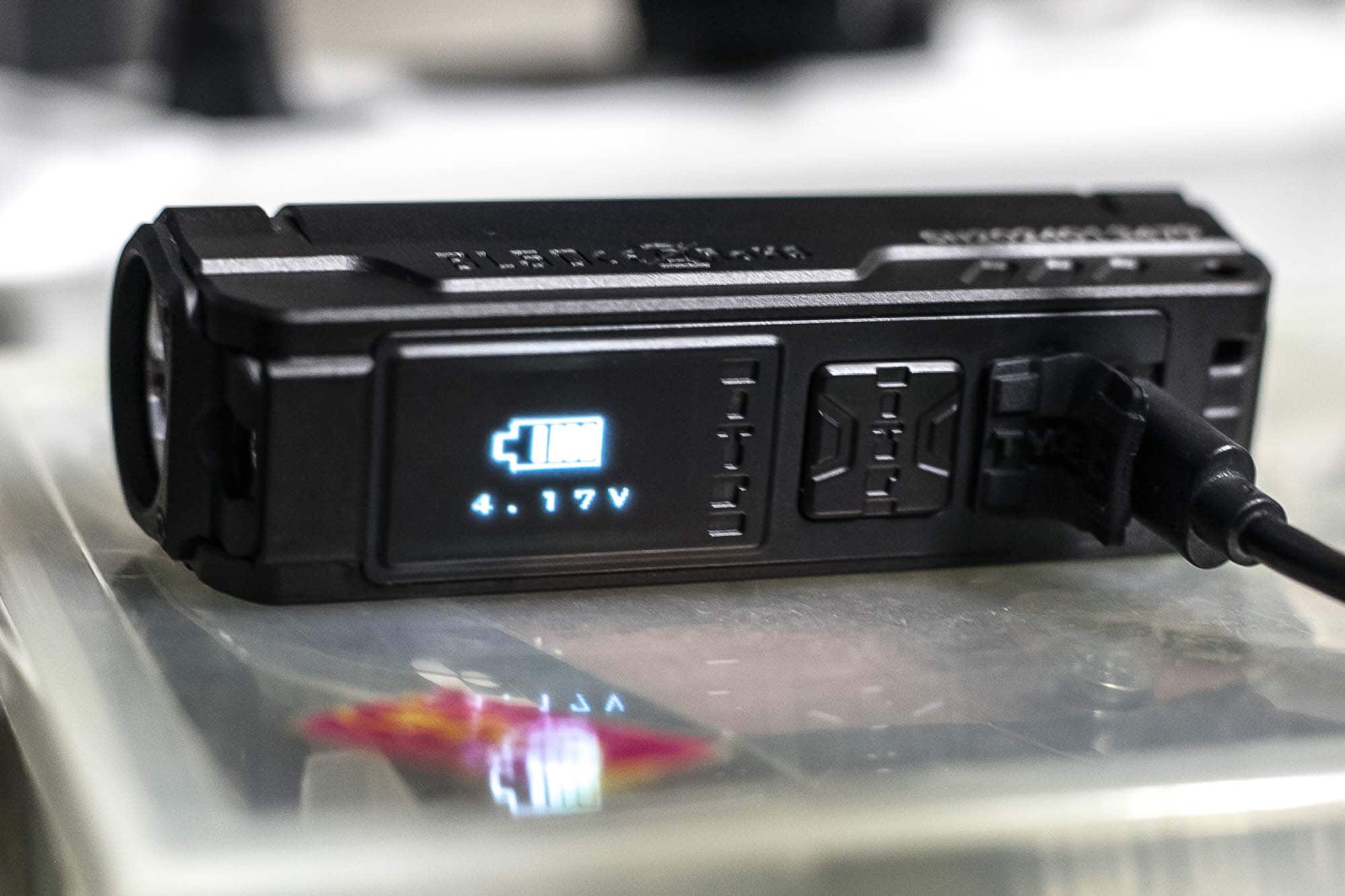

Performance test
This is the gear I use for testing:
| Gear | Purpose | Link to buy |
|---|---|---|
| Hagner E4-X | Measuring beam intensity (throw) | Inquire at Hagner.se |
| 2* Extech SDL400 | Lumens and logging runtimes | Amazon.com, Amazon.co.uk, |
| Leica Disto D2 | Distance for throw measurements | Amazon.com, Amazon.co.uk, |
| Sekonic C-800 | Spectrometer for LED measurements | Amazon.com, Amazon.co.uk |
| Uni-T UTi260B | Thermal Image camera | Amazon.com, |
Lumen measurements:
How Lumens are Measured: Understanding ANSI FL1 Standards How Lumens are Measured: Understanding ANSI FL1 Standards: The ANSI FL1 standards specify that output in lumens should be measured 30 seconds after turning on, as this is the standardized time for measuring brightness according to the industry standard. This is why we focus on this part in our measurements. The ANSI FL1 standards require an ambient temperature of 22 ± 3°C. We record the ambient the ambient temperature to identify potential reasons for any observed discrepancies.The output measurements in this review are based on my homemade integrating spheres, each equipped with an Extech SDL400 Lux Meter. For consistency and accuracy, a calibration light (Convoy S2+ with 249lm and a Convoy S2+ with 261lm) is measured before each set of lumen measurements.
One of the lux meters uses an ND camera filter for high-output lights to prevent the lux meter from maxing out. This is either the Kenko PRO1D ND16 for up to about 80,000 lumens or the Gobe ND32 for anything above.
All of my readings were taken from a fully charged battery
The measurements were taken manually at turn on and 30 seconds. The 10-minute numbers are taken from the runtime graph.
| Mode | Specified | At turn on | 30sec | 10 min |
|---|---|---|---|---|
| Fireflylite | 5 lm | 1 lm | 1 lm | – |
| Mid Low | 200 lm | 152 lm | 152 lm | 152 lm |
| Mid 1 | 600 lm | 479 lm | 478 lm | 475 lm |
| Mid 2 | 1,200 lm | 897 lm | 897 lm | 879 lm |
| High | 2,000 lm | 1,920 lm | 1,876 lm | 861 lm |
| Turbo | 3,600 lm | 3,112 lm | 2,848 lm | 886 lm |
Unfortunately, my measurements were a bit lower than specified, which is pretty common with Imalent flashlights.
Ambient temperature during testing:
- 18.9 degrees Celsius
Imalent BL50 Battery life and runtime
How Runtimes are Measured: Understanding ANSI FL1 Standards About ANSI FL1 runtime standards: The runtime is measured until the light drops to 10% of its initial output (30 seconds after turning on). This does not mean that the flashlight is not usable anymore. The last column shows how long the light actually works till it shuts off. If there is a + symbol, it means that the test was stopped at that particular point, but the light was actually still running. This happens on certain occasions, with certain drivers, firmware, or batteries.Runtime tests were conducted in my 50cm homemade integrating sphere, paired with the Extech SDL400 data logging Lux Meter. Temperatures from the moment the runtime test started.
| Mode | Specified | Runtime (ANSI FL1) | Time till shut off |
|---|---|---|---|
| Moon – | 208h | – | – |
| Mid Low (18.0°C) | 6h 28min | 9h 54min | 9h 54min |
| Mid 1 (19.7°C) | 3h 10min | 3h 00min | 3h 00min |
| Mid 2 (20.5°C) | 1h 16min | 1h 27min | 1h 27min |
| High (19.5°C) | 1h 13min | 1h 19min | 1h 19min |
| Turbo* (18.6°C) | 1h 9min | 1h 15min | 1h 15min |
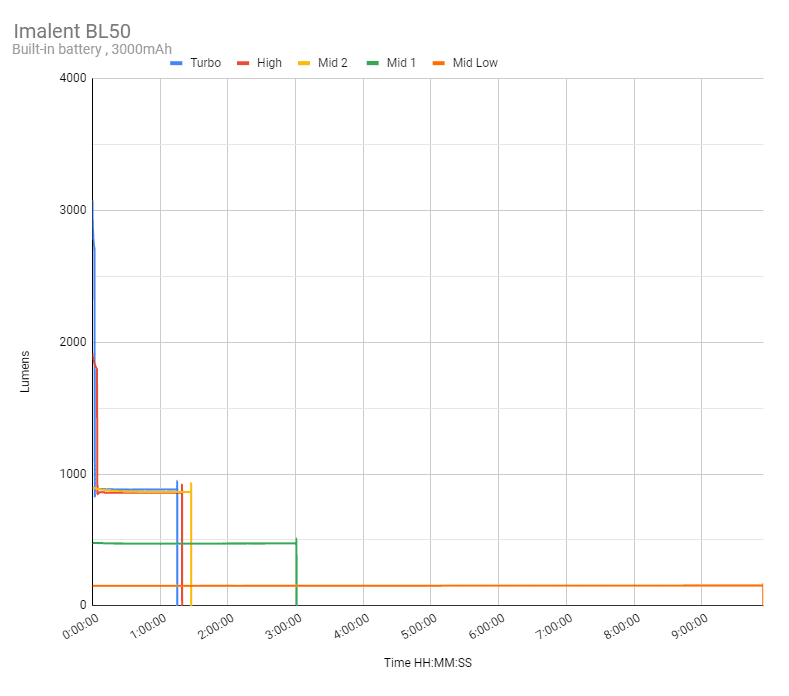
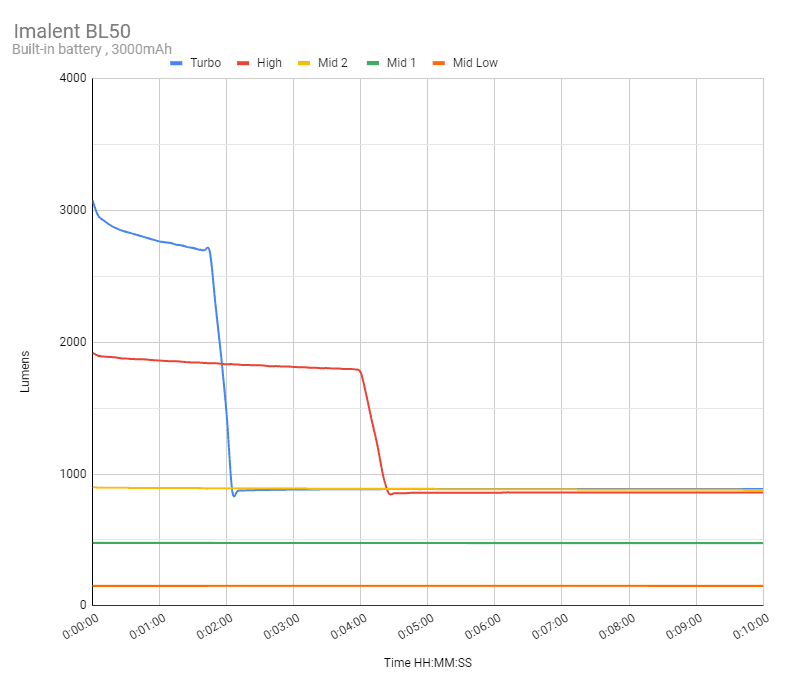
Imalent BL50 Peak beam intensity and beam distance measurements
About Peak beam intensity: Understanding ANSI FL1 Standards About peak beam intensity The calculated value of distance in meters at which the flashlight produces a light intensity of 0.25 lux. (0.25 lux is about the brightness of a full moon shining on an object). This means that the intensity has decreased so much, it becomes difficult to see darker objects, or objects that don’t reflect light. The columns ‘Meters’ and ‘Yards’ use rounded numbers.Measurements were taken indoors at 5 meters with a Hagner E4-X Lux Meter. The measurements were taken 30 seconds after turn on.
| Mode | Specified | I measured | meters | yards |
|---|---|---|---|---|
| Moon | – | – | – | – |
| Mid Low | – | 1,175 cd | 69 m | 75 yd |
| Mid 1 | – | 3,700 cd | 122 m | 133 yd |
| Mid 2 | – | 6,950 cd | 167 m | 182 yd |
| High | – | 14,550 cd | 241 m | 264 yd |
| Turbo | 45,780 cd | 22,275 cd | 298 m | 326 yd |
You see my measurements don’t even come close to the specified intensity.
Ambient temperature during testing:
- 21.3 degrees Celsius
Beamshots
For the following beamshots, I used a Canon EOS 5D Mk2 with a 50mm lens. Manual settings: ISO1600, 1/4sec, F4, 5000K
The shed is about 65 meters / 71 yards away, and the reflective fence is about 200 meters.
Explore and compare the beamshots from the following flashlights:
- Imalent BL50.
- Nitecore EDC27
- Wuben X2
Please note that the following beamshots are mainly intended to showcase the beam pattern and beam quality, rather than overall performance. These images are typically taken directly after activation, and in different seasons or weather conditions, and therefore do not fully represent its overall performance. For accurate performance metrics, such as output, beam distance, and runtimes, you need to look at the performance section of this review.
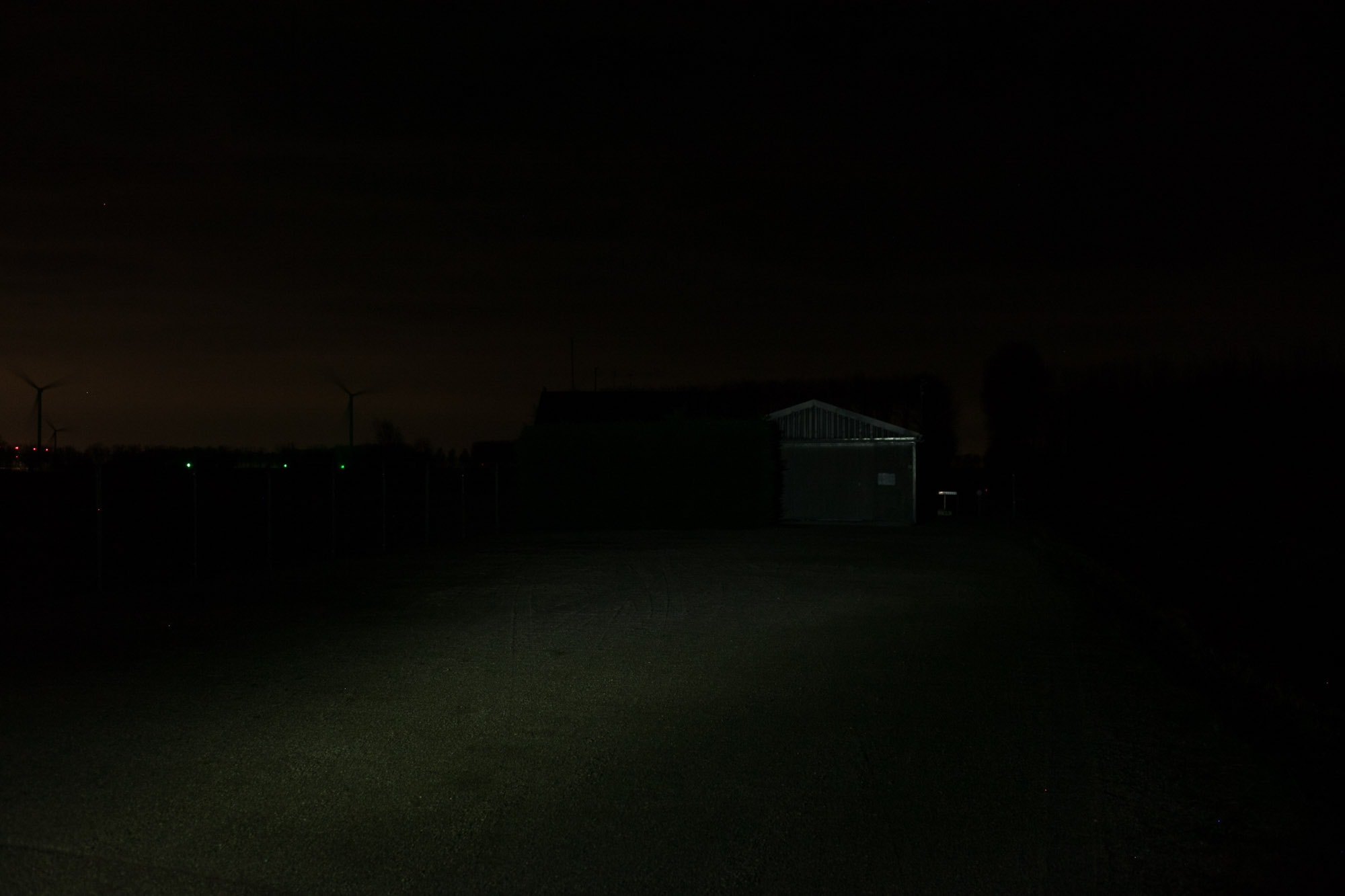
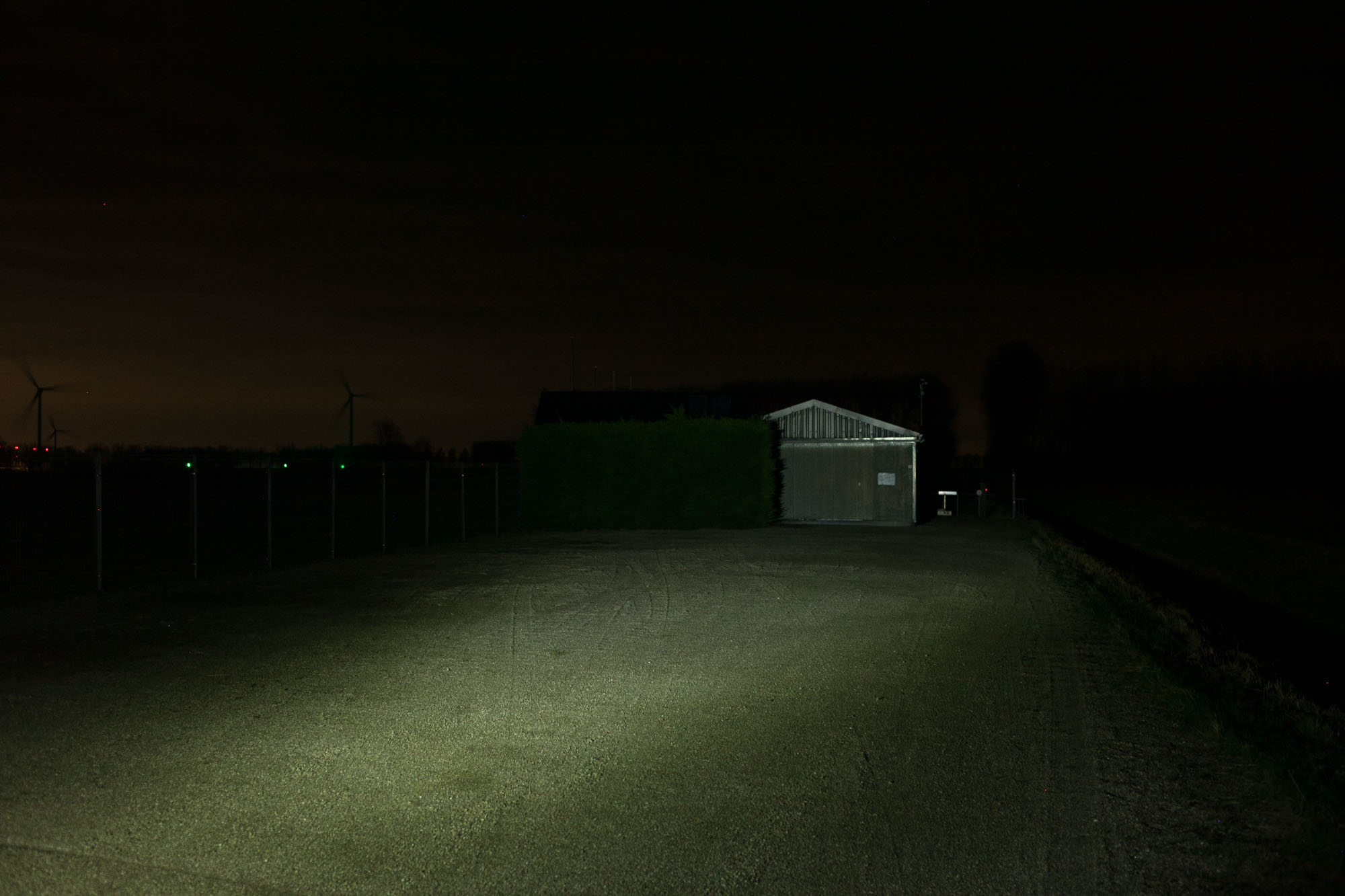
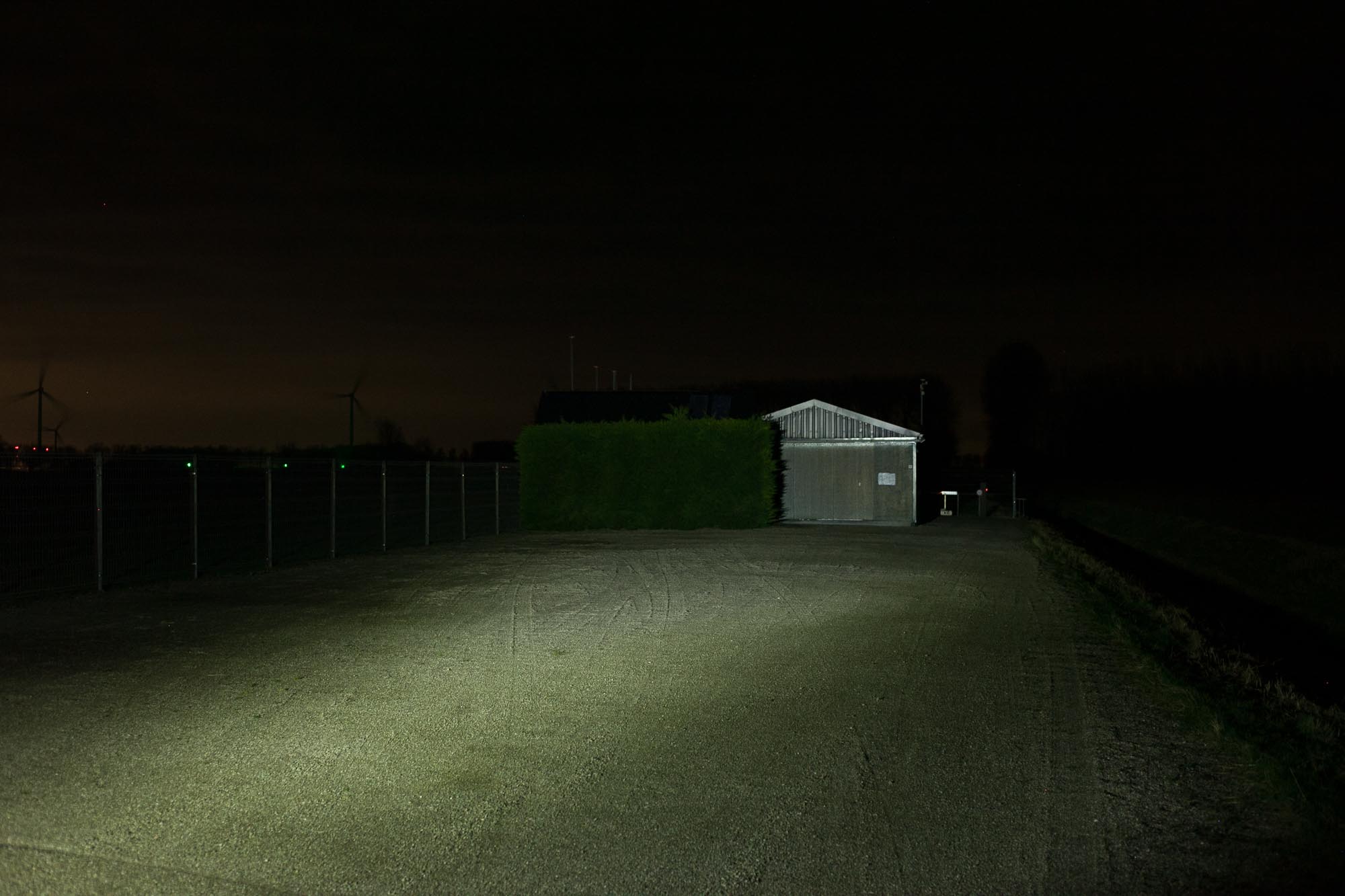
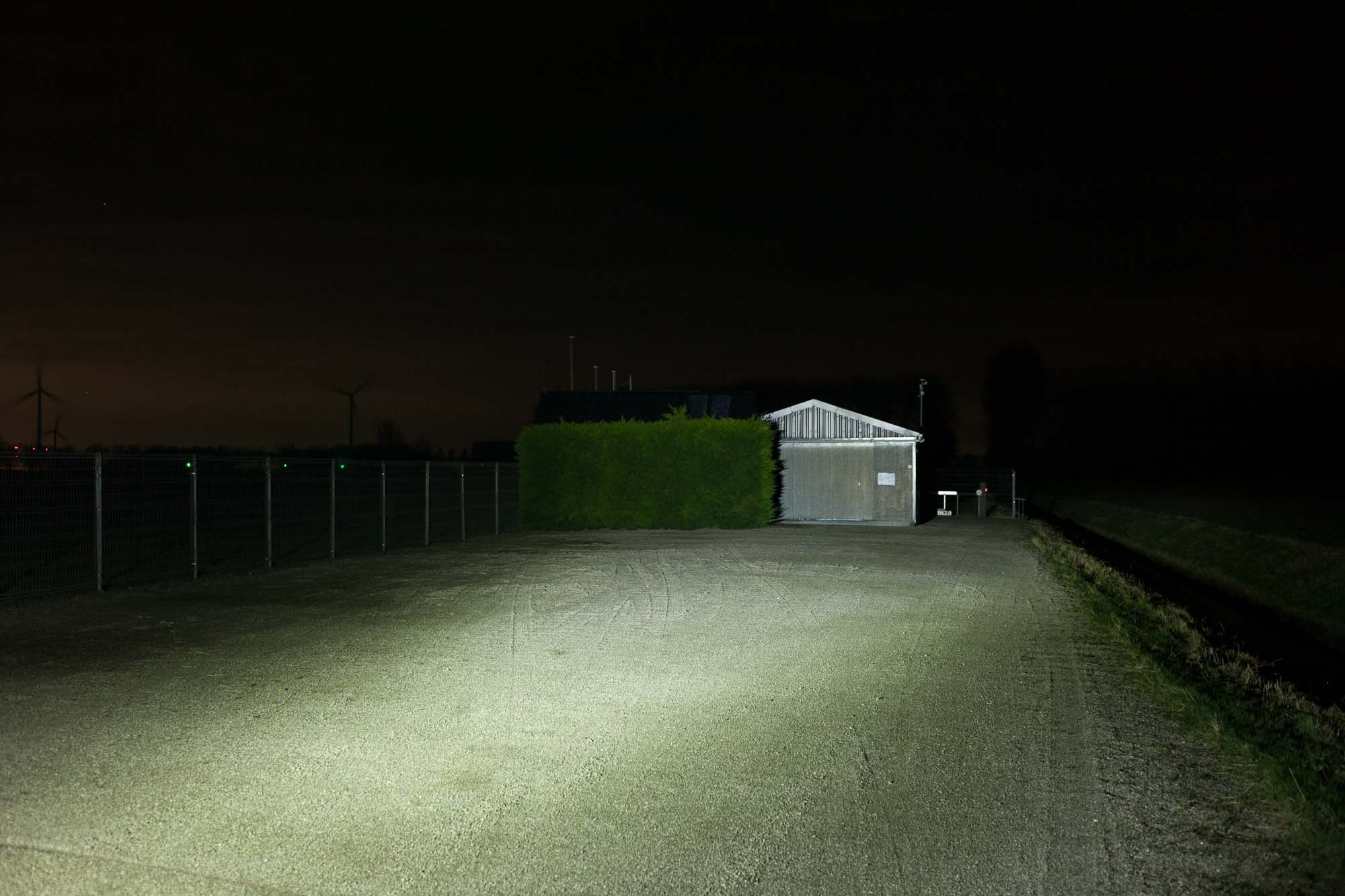
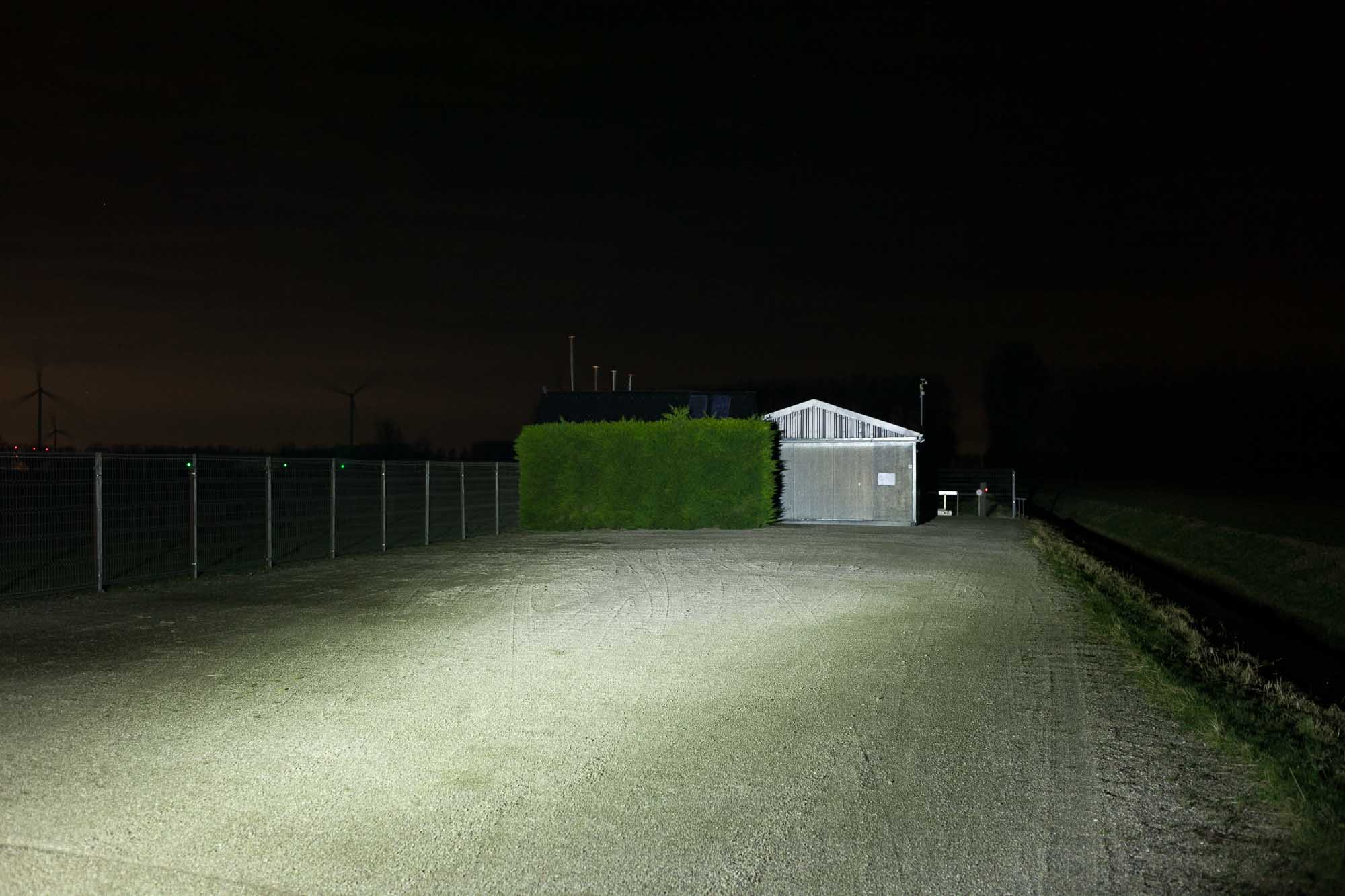
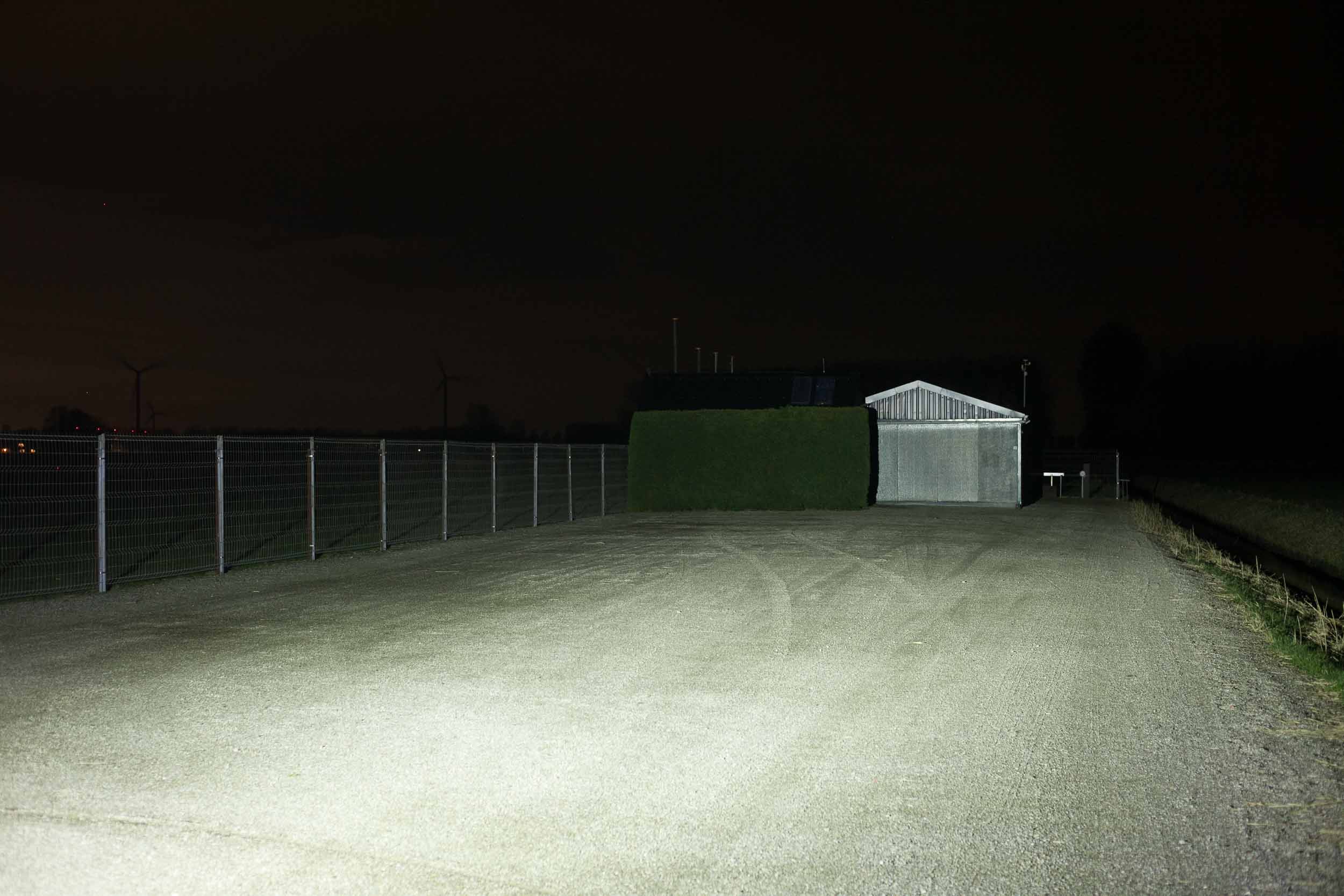
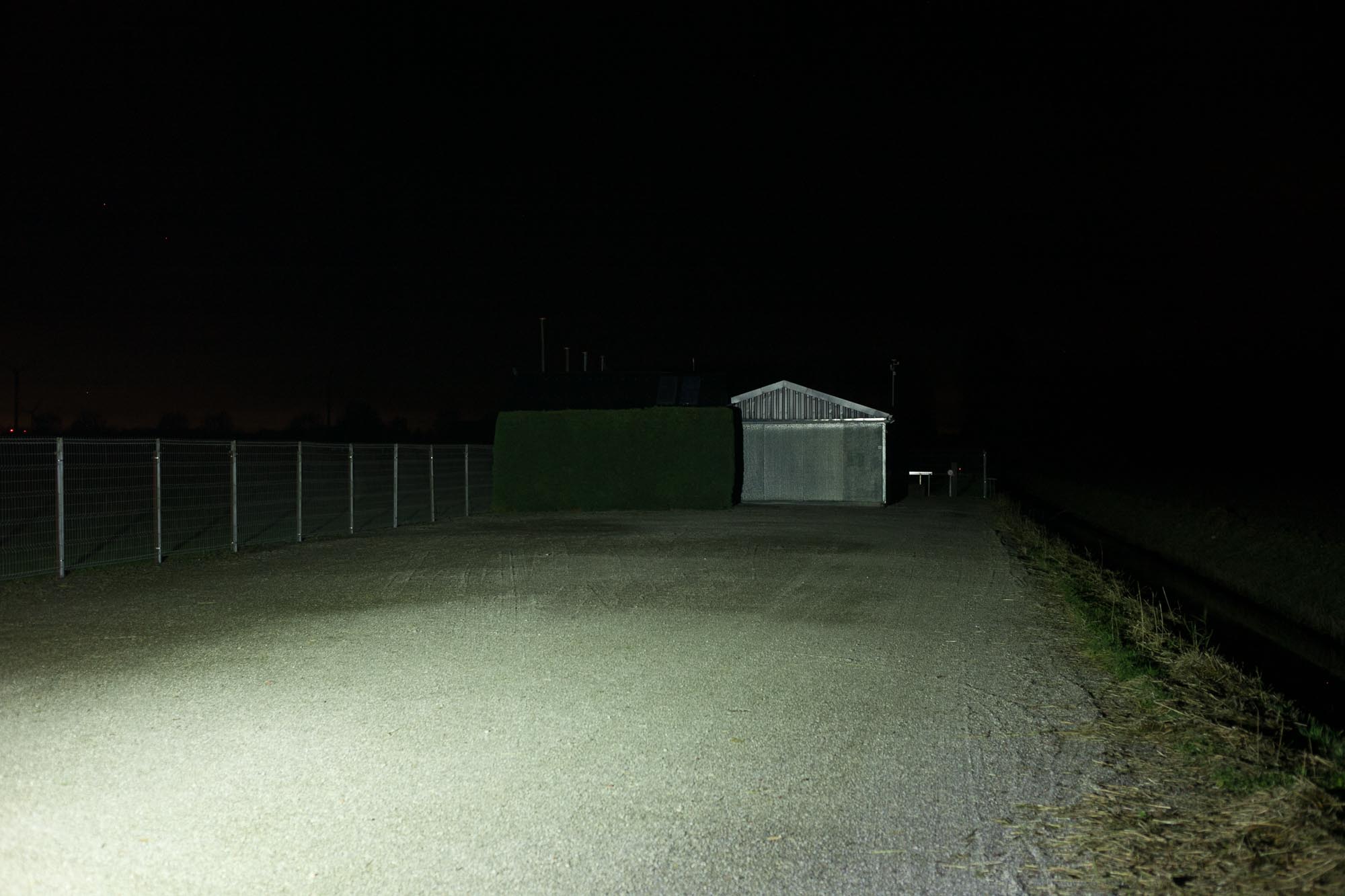
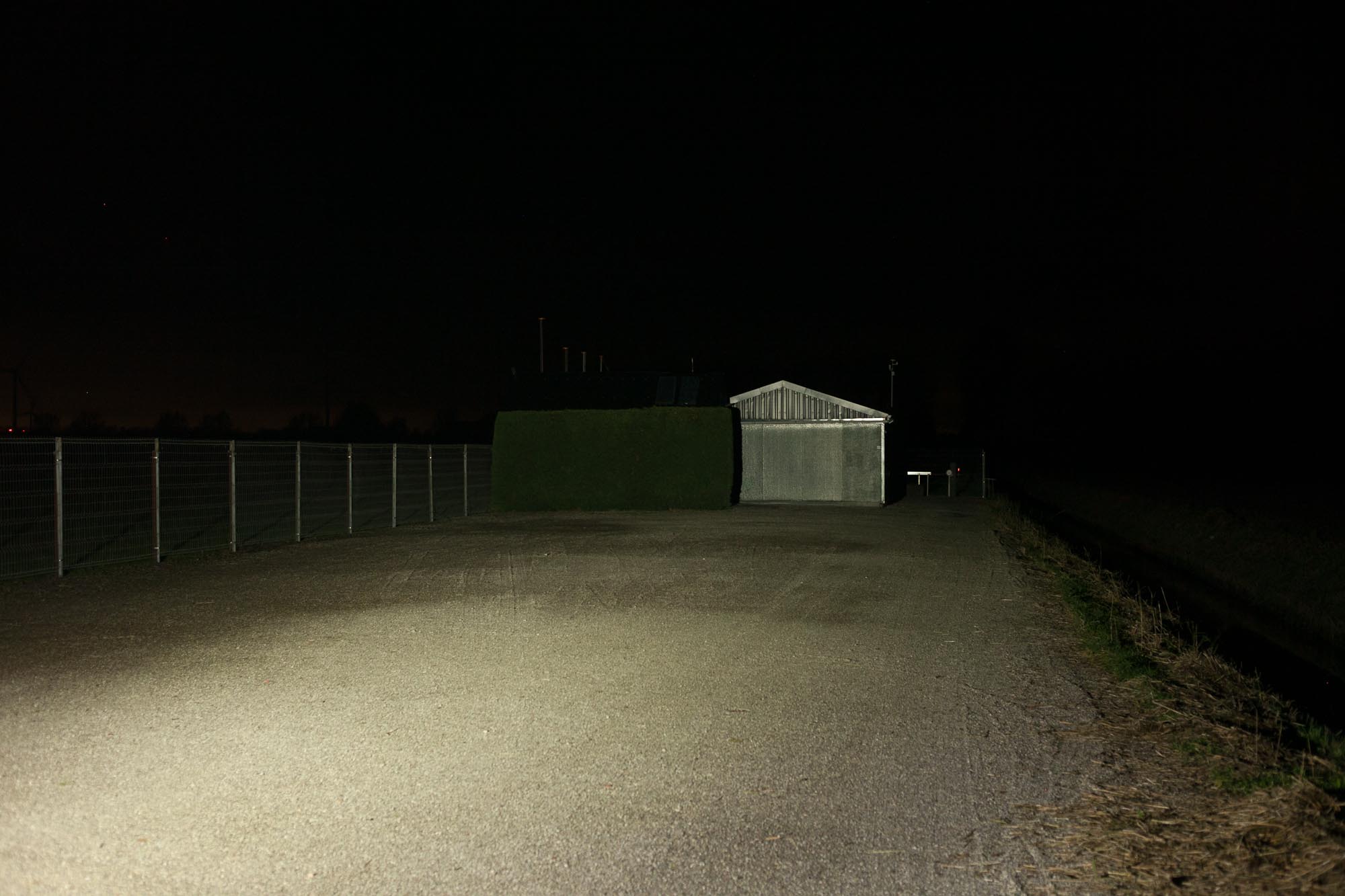
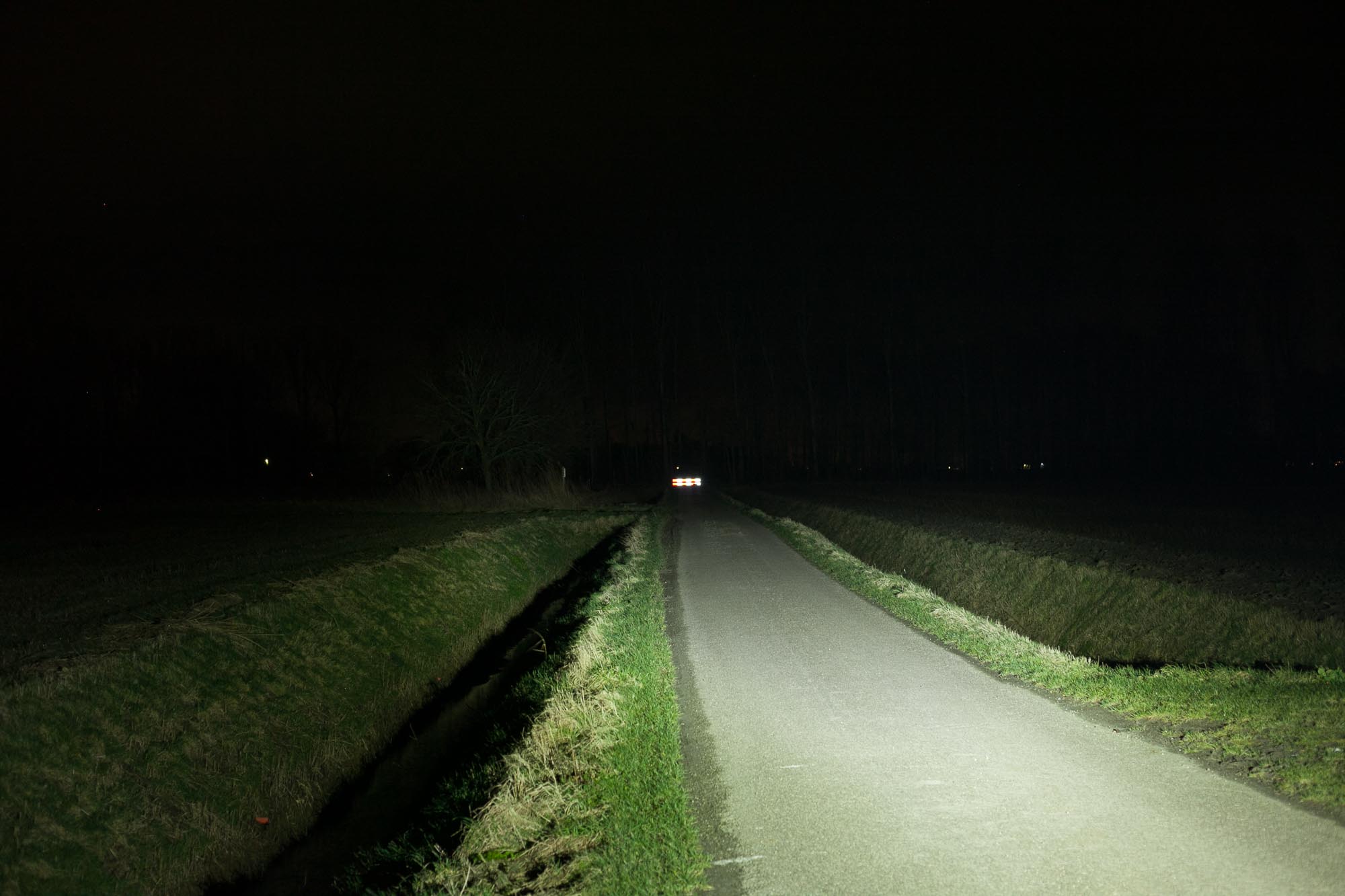
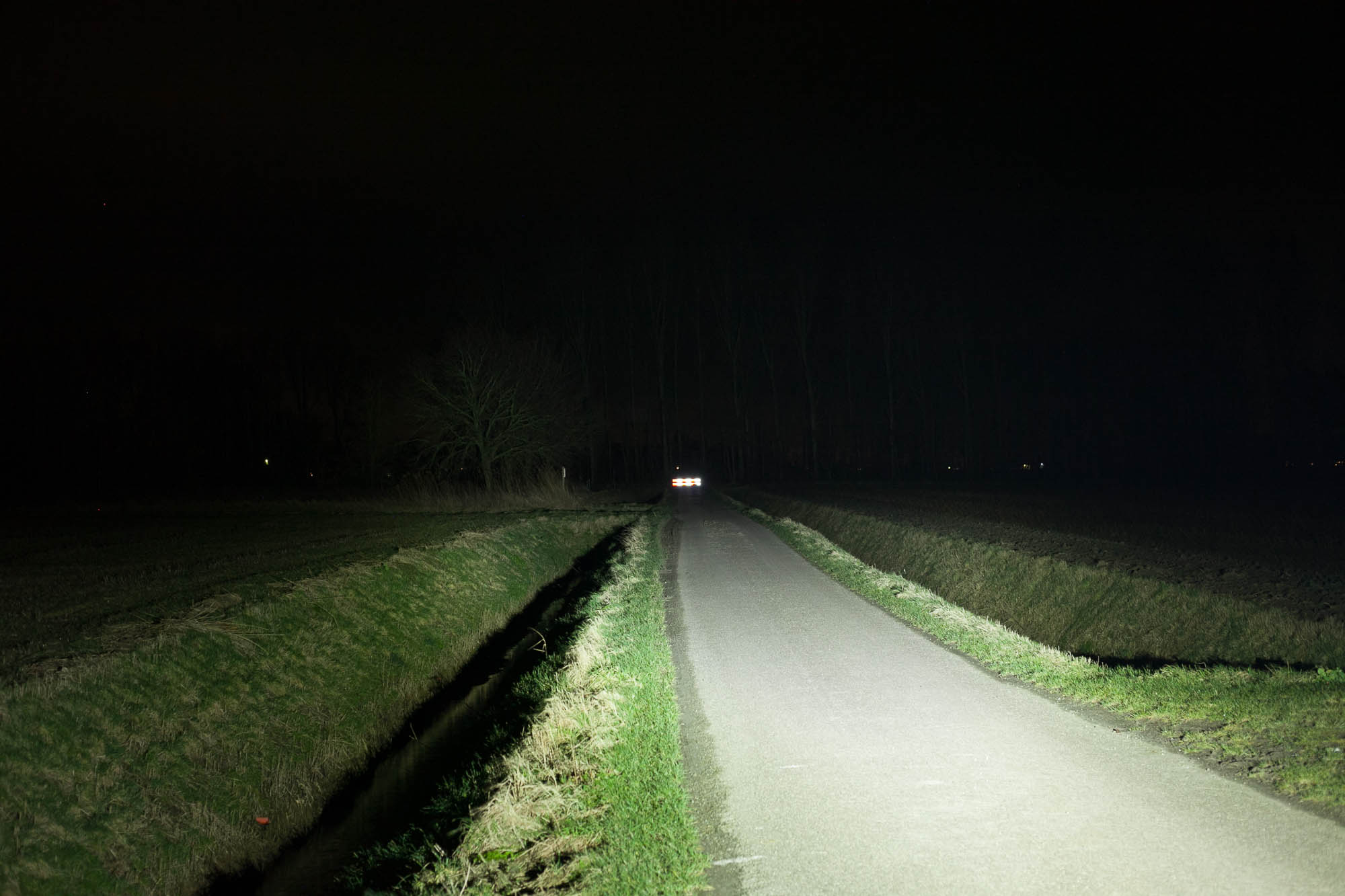
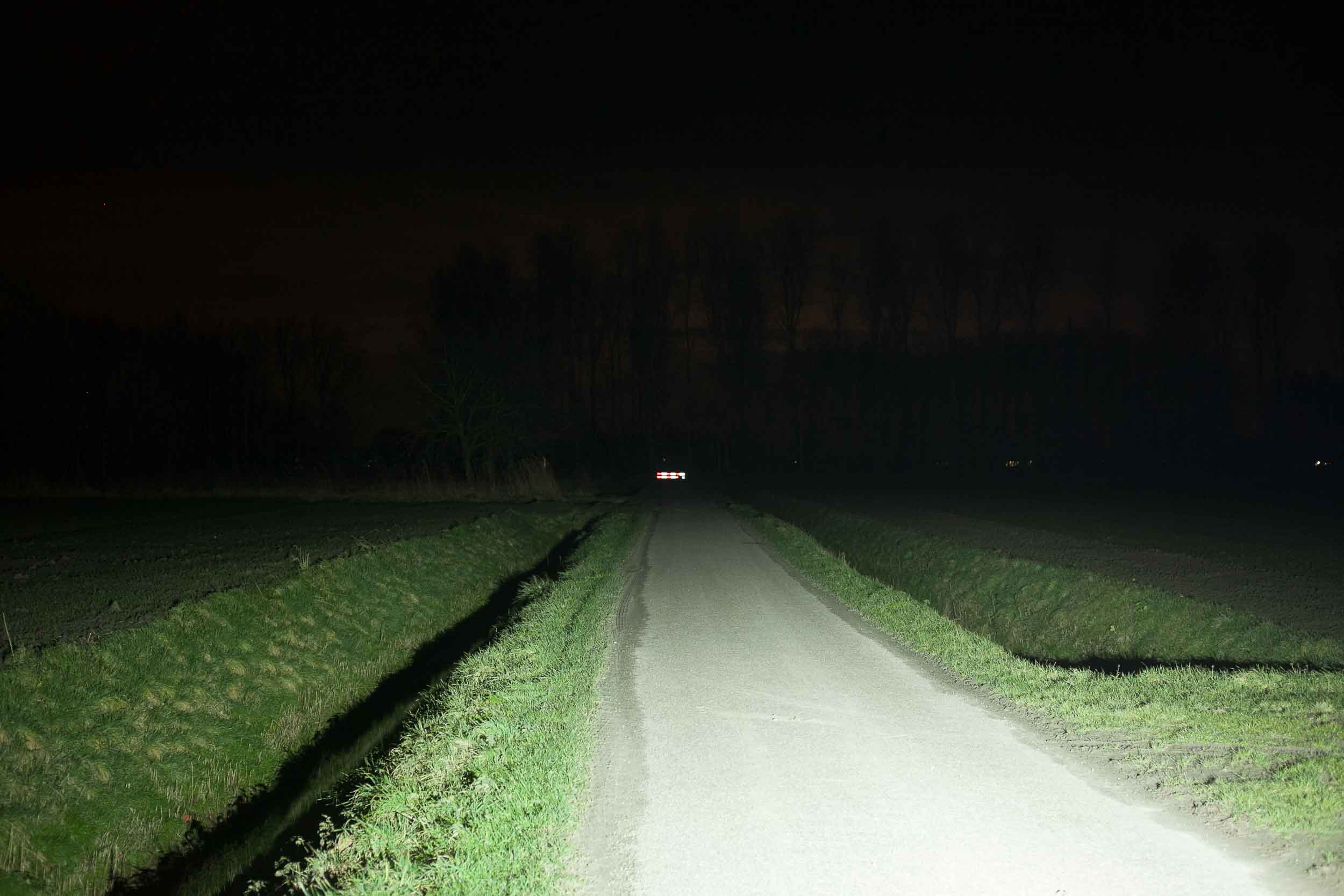
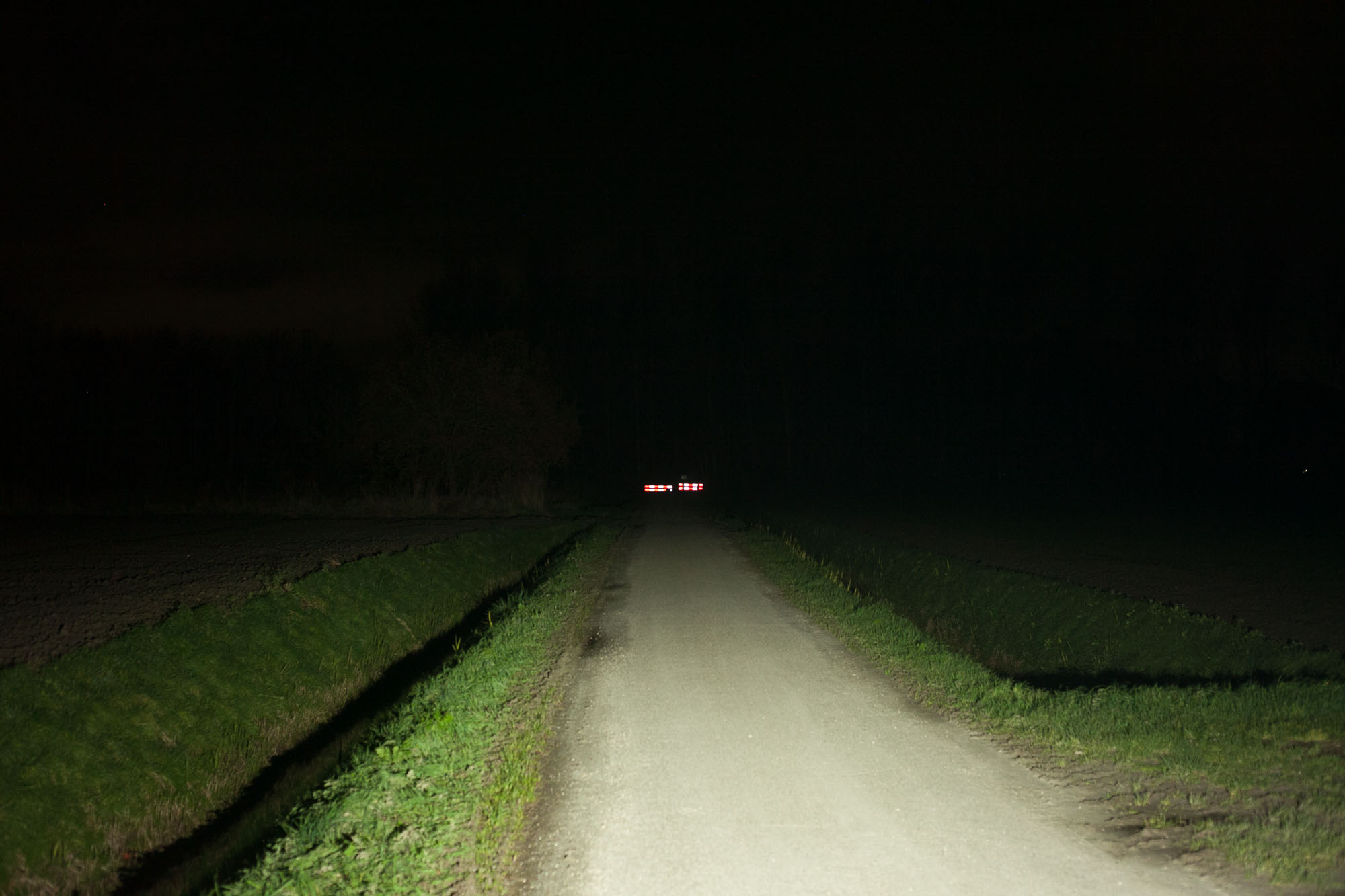
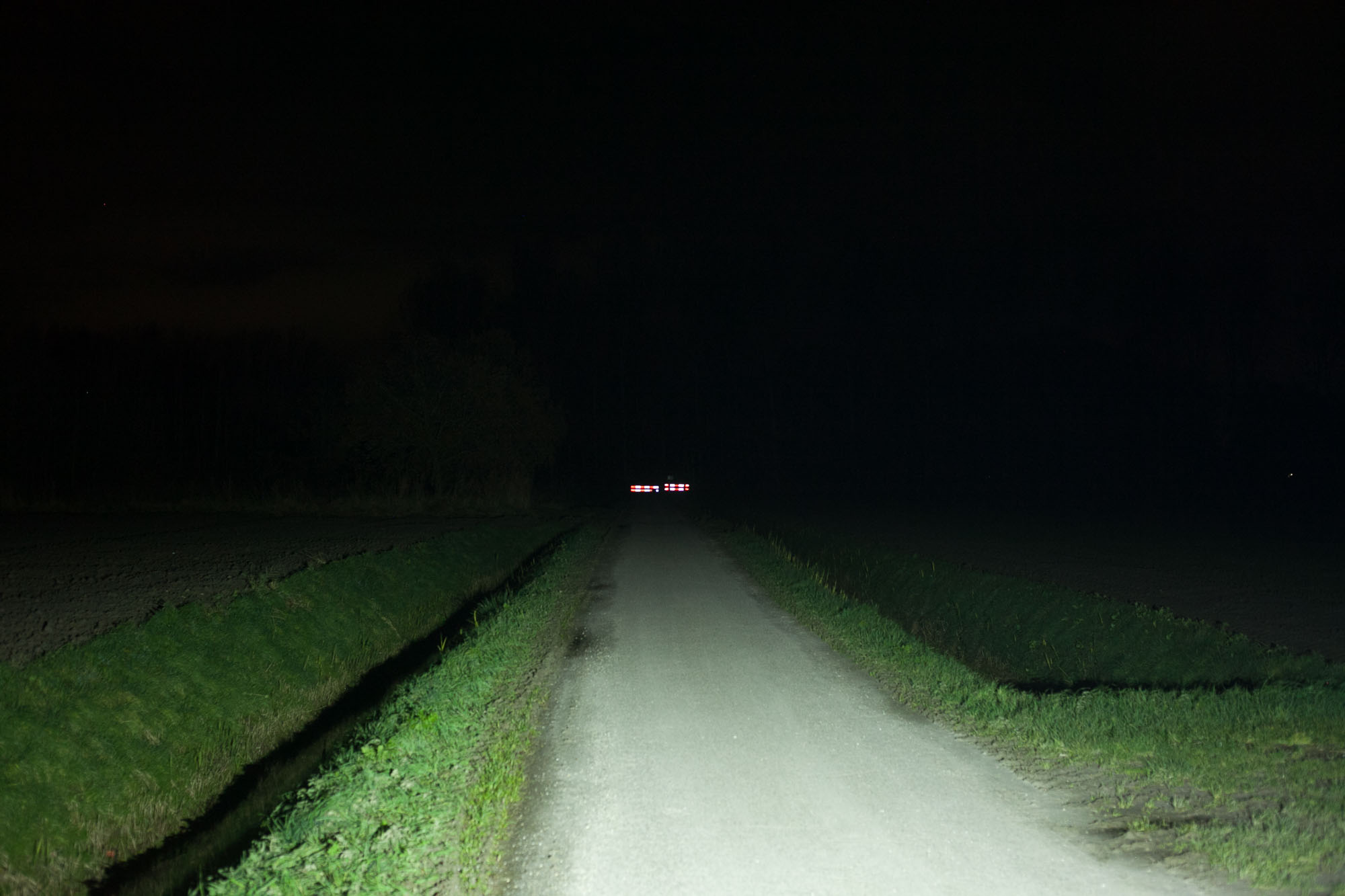
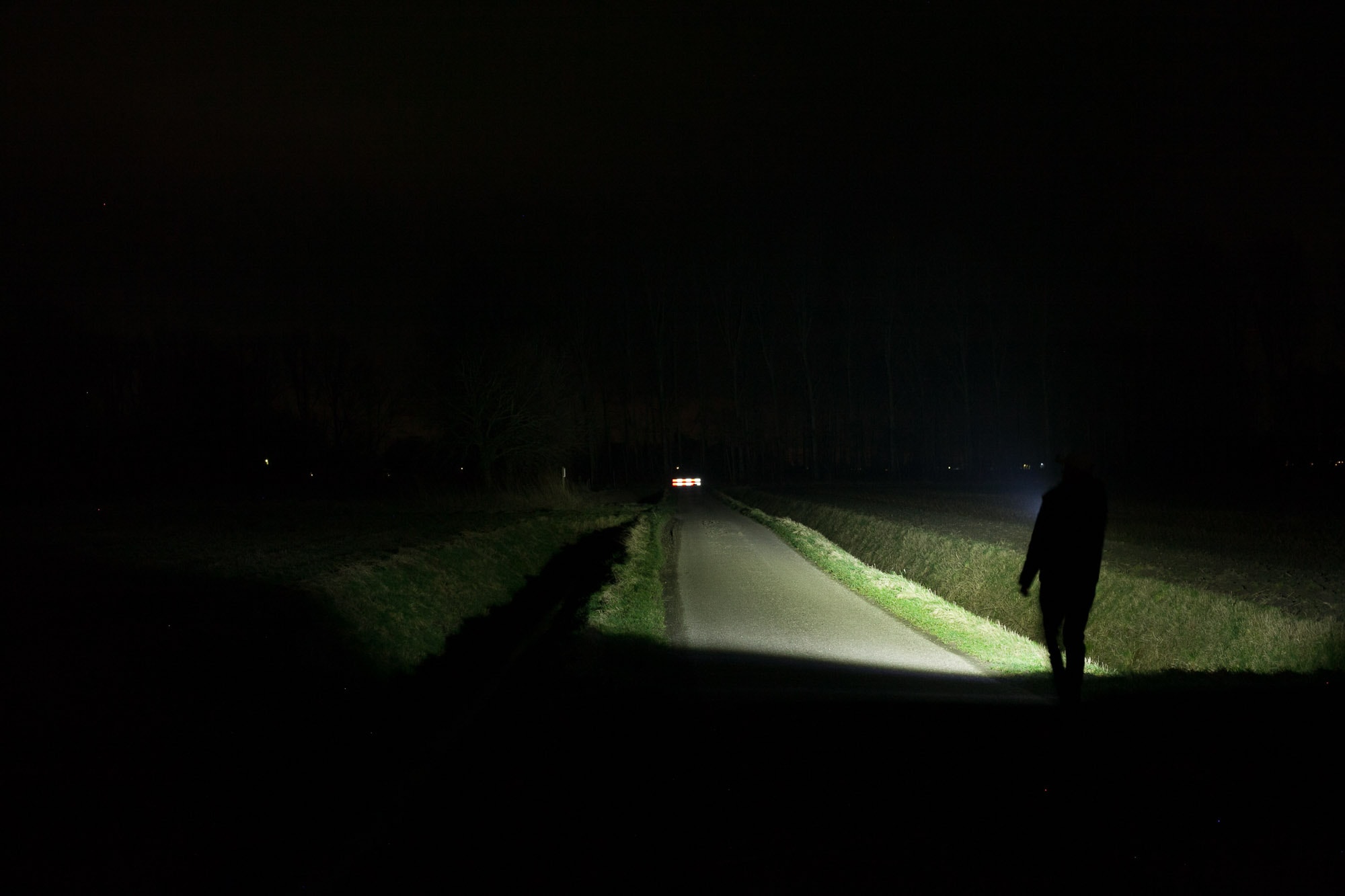
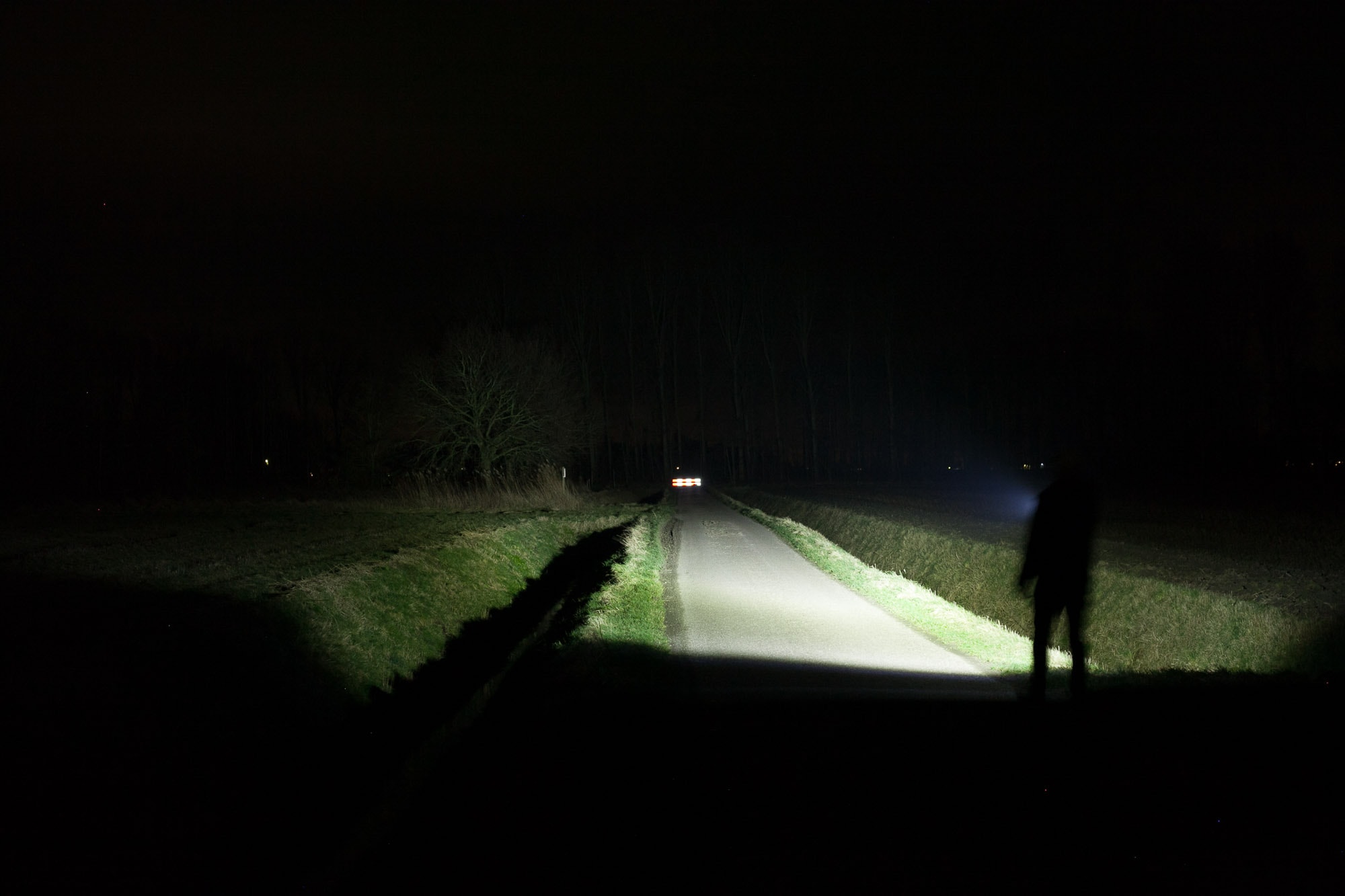
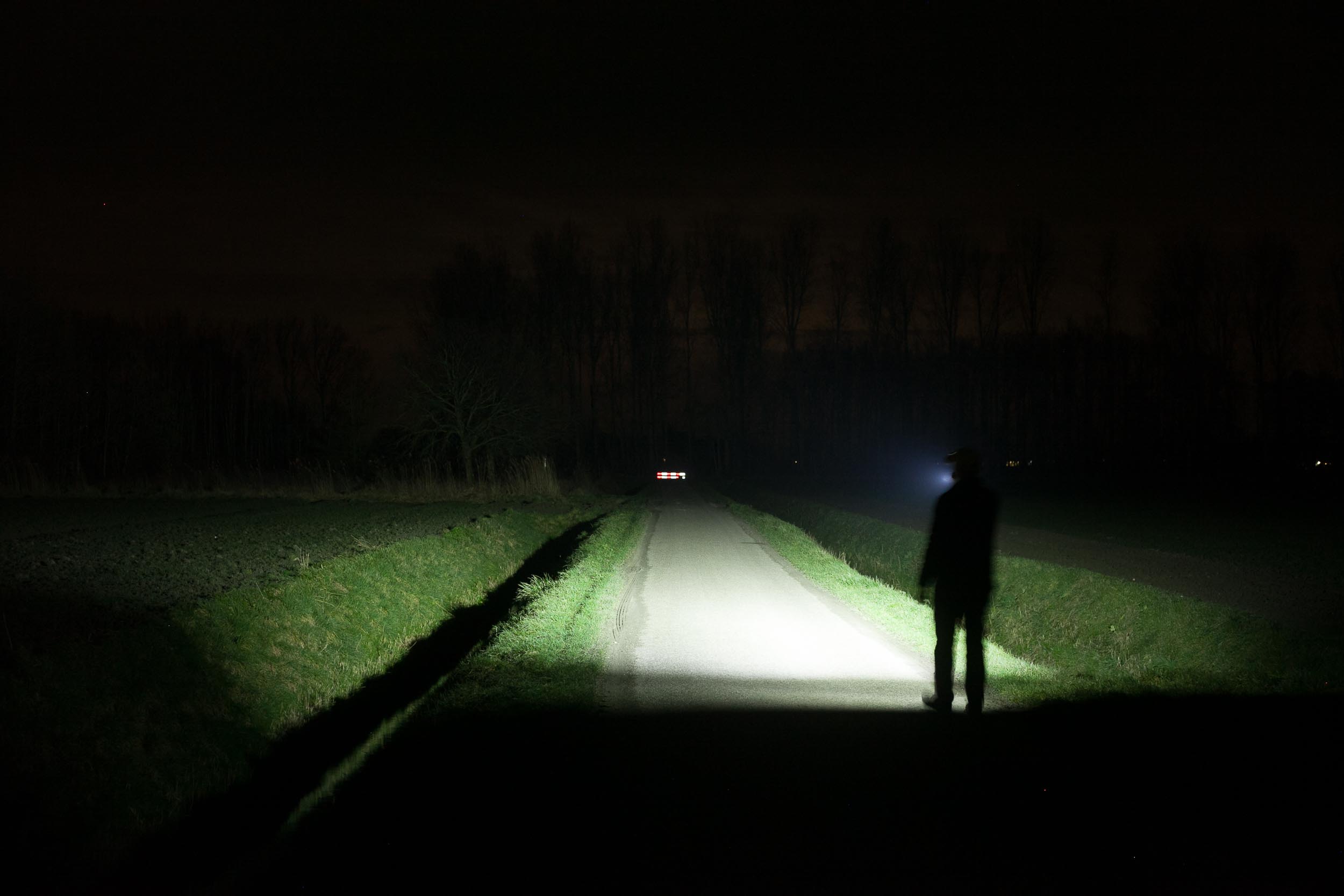


Disclaimer: This flashlight was sent to us for review at no cost by Imalent. We have not been paid to review, nor have we been holding back on problems or defects.
Final Verdict
Pros
- Plenty bright for its size
- Good, high sustained output
- Special Low mode and UV mode with secondary switch
- Onboard USB-C charging
- Fast charging at 9V, ranging from 45-49 minutes
- One flat side for very stable use
Cons
- The naming of modes in the manual is a little confusing
- The manual lacks info on the strobe’s output and runtime
- Not reaching the claimed beam intensity and output
- It gets pretty hot
Explanation on star ratings:
1: Avoid: my phone flashlight would be a better choice – 2: Poor: significant defect or issues; almost unusable – 3: Average: some defects or issues; but still usable 4: Good: recommended (minor issues) – 5: Great: highly recommended

4-4.5 stars: ★★★★⋆
While our star rating provides a reliable indicator, we encourage you to read the full review to make an informed decision based on your own needs and preferences.
Imalent is known for its high-power flashlights, but they also make a couple of smaller flashlights like the BL50. It’s an EDC-style flashlight, and it’s not trying to be the ‘brightest’ in class. So, what is it trying to achieve?
I’m not sure where this one would fit in. It has a dual-light source, combining UV and white light. So, I guess it would be good for some home inspectors or just for normal EDC. The OLED display makes me think it’s not meant to be used for rough chores, though.
The dual-switch design is also interesting, but I think the switches are a bit too sensitive.
Regarding performance, the BL50 is very good, with a pretty high sustained output. So no complaints in that regard. I just wouldn’t say I like Imalent’s exaggerated claims.
So, will these features and performance meet your needs? You decide!
Buy your Imalent BL50 here:
If you order this flashlight from Imalenstore, make sure you add our exclusive coupon code at checkout for an extra 10% off. Coupon code: 1lumen
1lumen selects and reviews products personally. We may earn affiliate commissions through our links, which help support our testing.